|
Our final days in Egypt were spent resting and relaxing by the Red Sea. After many busy days of touring the country our next 4 days were spent laying by the pool and enjoying the sun. The hotel that we stayed at was an all-inclusive property so all our meals and drinks were included which made it easy to make decisions each day and we could really just relax, sleep and read books. The food at the hotel was a buffet setup. After a few days it does tend to become a little bit repetitious. One evening we did have a made to order dinner at the Italian restaurant which gave us a bit of a change. The service was very good and the food tasty so we were generally happy. One evening we also took an Uber to a small town about 30 minutes from Hurghada to have a change of pace. We enjoyed a stroll on the shoreside boardwalk and dinner on the patio. Everything was super fresh and it was a wonderful evening. One day we planned a half day excursion with one of the companies that roams the resort offering activities. We chartered a private boat for a morning of snorkeling. The water in the Red Sea is crystal clear and has amazing shades of blue. We were taken for a ride, approximately 30 minutes out, to a reef where we were given snorkel gear. We popped into the water from the back of the boat with a guide. He slowly worked his way through the water showing us so many kinds of fish, coral, plant life and other sea creatures – it was amazing. Below is a video that shows our highlights from Hurghada but also includes footage from under the water while on the snorkeling trip. It is some of the best snorkeling we have ever done. One day Denis also went golfing at a course in the area. In Egypt starting early is really necessary due to the heat. He enjoyed a morning of golf and had the course almost to himself. The scenery is pretty spectacular. At the end of four days, it was unfortunately time to return home. Our adventure in Egypt was everything we hoped it would be – an education in history and culture, awe inspiring due to the incredible structures and a truly magical experience that should be something everyone enjoys. We know we will definitely be back.
0 Comments
Our second day in Alexandria started with one of the most famous sights located in this city – the Library of Alexandria. Interestingly the current library is a very modern building. The first library was founded by one of Alexander the Great’s generals named Ptolemy I back in 283 BC. Since Alexandria was the main port there were international ships coming from all different countries so the rulers took it upon themselves to “request” books from the ships that would come in and they would either keep them or sometimes copy them to put in their centralized knowledge centre. The museum was a place for studying and over 100 scholars lived there to write, lecture, research or translate and copy documents. It has been estimated that at one time there were over a half million documents within the premises. There are several stories that have been recounted about the fire that ultimately destroyed the library but one of the more popular, points the finger at Julius Caesar. In 48 BC Caesar was cut off by an Egyptian fleet at Alexandria and in retaliation ordered the ships in the harbor to burned. Unfortunately as a result the fires also spread onto land and eventually burned the library to nothing taking with it ancient history, literature and learning. The existing building wasn’t completed until 2002 even though reviving the library was originally proposed in the early 1970’s. Now the beautiful and modern building is a library, a cultural centre and even houses a school for training professional staff to work in libraries in Egypt and the Middle East. The inside is absolutely stunning with multiple levels and slanted huge windows from floor to ceiling on one side. You can find books by authors from all over the world – we even located the Canadian authors section. The library houses both permanent and guest exhibits and collections on a variety of topics and interests. Some are included with your admission and others are at an additional cost. The facility houses many research centres and there is cutting edge technology at this site as well. One example is a table that show the human body and all it’s inner workings for medical students to use. And during our tour we were informed that you can access millions of complimentary books from their online archive just by registering for a membership. They believe in sharing all their resources and a large project is ongoing to place all their materials online. This is not your average library – it is an incredible site to see and really must be toured with their guides. We spent a couple of hours exploring the library and then we were off to visit the Roman Amphitheatre located in the centre of Alexandria. This amphitheatre dates back to the 2nd century and was found by some workers sent to clean up the area during the 1960’s. The amphitheatre has a diameter of 33 metres and consists of 13 rows made from European white marble however the columns were made from granite that was transported from Aswan. Unfortunately, during one of the major earthquakes in the area much of the amphitheatre was damaged. Based on the size of the structure it is suggested that it was built for meetings of important figures and officials and likely not for theatre or concerts. For it’s age and the fact that it was covered by sand and gravel for so long, it is in really great shape and is the only one of it’s kind in Egypt. After wandering around the Roman structure, we drove around the city taking in the sites, sounds and smells of this vibrant city. The bustling markets, the stunning architecture, the mobile tea carts, the friendly people are all what contribute to this amazing city. We loved everything about it and will definitely be back. Our touring was topped off with a massive lunch at a BBQ restaurant and then it was time to head back to Cairo. The drive seemed shorter on the way back to the airport where we dropped off Karen and Geoff at their hotel for the night. We had a later flight to take us on to Hurghada for a few days of rest and relaxation. We had a quick hour-long flight, we were picked up by our driver at the airport and whisked off to our seaside resort. It had been a long but certainly enjoyable day.
Continue to Day 11 - click here. Our first day in Alexandria started with a wonderful breakfast on the outside roof patio at our hotel. The beautiful breeze from the sea was very welcome after having spent the rest of our trip in the desert regions. Alexandria overall has a Mediterranean feel and was much cooler in temperature. We were very excited to explore this beautiful city. Our first stop was at the catacombs located in the middle of the city. Upon arrival at the site you have no idea what actually lies underground. After a quick look at the artifacts spread around the entrance, we listened as our guide wove the tale of this fascinating site. This massive burial site was found accidentally in 1900 when a cart accidentally fell into a pit and magically led to the discovery under the ground. The underground tunnels date back to the Greco Roman period and at the time of the 2ndcentury was dug down 35 metres (115 feet) and consisted of three levels. It was likely originally a private tomb but over the years was later converted to a public cemetery and could accommodate more than 300 corpses. Unfortunately we were not allowed to take any pictures underground. We entered via a spiral staircase that brings you down into a large area with benches and we were told by our guide that many people would come first to have a burial feast, then again 40 days later and then annually on the death anniversary. There are several burial chambers each holding a sarcophagus. There are also many shelves built into the rock that house coffins. The carvings and symbols inside are in several different styles including Greco-Roman, ancient Egyptian and Pharaonic. After exploring a few of the passageways and learning about the different symbols inside we surfaced to the top and started on our way to our next stop. The Citadel of Qaitbay is a stunning fortress built on the sea dating back to the 15th century. It is built upon the site of the famous Lighthouse of Alexandria which was one of the Seven Wonders of the Ancient World. Unfortunately, the lighthouse was destroyed over the years due to several earthquakes. The original building constructed on this spot in the 14th century was destroyed in the 1800’s and the existing building was rebuilt around the turn of the 20th century. Many of the stones and columns came from the original tower that was there originally. Inside is a mosque and naval museum. There are some lovely mosaics on the floor but inside there is not a lot to see. The outside views however are spectacular. We walked around the entire structure including climbing up to the top to see the sea. It was incredible and we could have hung out there all day! We then stopped for lunch at a wonderful restaurant on the water and had a fantastic fish lunch. It was so fresh and super tasty. A fantastic way to spend an hour enjoying the breeze and a stunning view. And we also then stopped at the Starbucks on the main street – and you wouldn’t know that you were in Egypt. It is one of the most consistent brands I have seen everywhere across the world. Our last stop for the day was the El-Montazza. Located here is a beautiful palace that was built in the late 1800’s but is not open to the public. You can wander the well-maintained gardens in the park that surround the palace. We also walked out to the end of a breakwater where we could enjoy the waves crashing in front of us. The views in Alexandria are really very beautiful and it was so very nice to be by the water. After returning to the hotel we had a rest and then headed up to the roof patio to have drinks and dinner. It was a wonderful evening – our last with Karen and Geoff. It was an evening of singing, dancing and wonderful company. Such a fantastic end to the day.
Continue to Day 10 - click here. After a busy day in Aswan, it was time to check out from our Nile cruise and move on to the next city. But first our day started with a very early morning so we could drive to Abu Simbel. The drive took approximately 3 ½ hours and was through nothing but flat, dry desert. The village is located on the western side of Lake Nasser near the border with Sudan. Suffice to say there was absolutely nothing to be seen during the 300 kms except one very small road side stop called the Oasis - aptly named. For this drive we had two drivers in case something was to happen to the first since there is nowhere to stop for assistance. Now that I have experienced this drive I definitely recommend to clients that they take the quick flight from Aswan to Abu Simbel. Our guide spoke to us as we approached the temples and let us know about why this site is one of the most fascinating in Egypt. The Abu Simbel temples are an UNESCO World Heritage Site and are part of the collection of temples known as the Nubian Monuments. They date back to the 13th century and were commissioned by Ramses II. The massive temples were built to commemorate Ramses’ victory at the Battle of Kadesh and are basically a tribute to himself and his Queen – Nefertari. There are two temples on the site – the Grand Temple and the Small Temple. Both are incredible to see. As the names imply the Grand Temple is larger and took almost 20 years to build. All four of the large statues on the outside are huge depictions of Ramses himself – reaching 20m (66 feet) in height. Around his legs are smaller statues of his wife, mother and daughters. The interior is amazing with a triangular layout and each room decreasing in size until you get to the sanctuary. The hall has massive columns and carvings on the walls that show battle scenes. Once inside the sanctuary you can see four statues cut into the wall – Ramses and three gods. An interesting fact is regarding the position of the axis of the temple that allows twice a year - in October and February the rays of the sun to come through the sanctuary and illuminate all but one of the statues – the god of darkness. Check out my video below that is filmed from outside the temple and also from within the sanctuary. The columns and carvings are in impeccable shape and this is even more amazing once you understand that the temples were actually abandoned and over time became covered by sand. They were eventually discovered by a Swiss orientalist who after many attempts was able to have the temples dug out and successfully entered inside. In the late 1950’s the Aswan High Dam was being constructed and it was apparent that many of the Nubian monuments were in danger due to the rising waters of the Nile. It was publicized that relics from this ancient human civilization were under threat and international donations were collected to fund a solution. It became clear that the temples would need to be moved. During 1964 to 1968 the entire site was dismantled, lifted and moved to a new location 65m higher and 200m back from the river. The blocks weighed an average of 20 tons and were painstakingly moved and reassembled in the new location. It is really hard to believe that such a challenge was even able to be completed. The Small Temple is not really small – since the statues out front are still 10m (33 feet) tall. These are of Ramses and his wife Queen Nefertari. And interestingly they are the same height which was unusual since Ramses typically made statues depicting himself larger than any other. The inside has pillars and drawings depicting the queen, Ramses and many different gods. After wandering both the temples for a couple of hours, we had an interesting exchange with a security guard who asked if we would like to hold his machine gun for pictures! We politely declined but to make sure we didn’t insult him we did take a photo with him and also gave him a gratuity so he remained content. Our guide then took us to a lovely spot for lunch where we enjoyed the coolness of the inside seating. Our lunch was delightful and just what we needed before the long ride back to Aswan where we would catch a flight to Cairo. This was going to make for a very long day with tons of driving since upon arrival in Cairo we were picked up and our driver took us onward to Alexandria. I must say that it was a very quiet ride since we were all very tired and mostly slept along the way. We arrived into Alexandria at 1:00am which was still very much awake due to Ramadan festivities. We fell into bed at the Alexandria Windsor Palace Hotel looking forward to exploring Alexandria the next day.
Continue to Day 9 - click here. Our 8th day in Egypt was spent in ancient Aswan, the southern-most city in Egypt with a population of approximately 300,000. This city is considered to be one of the driest, sunniest and hottest places in the world and as such, our early morning excursion began at 7:00am to try and avoid the mid-day heat. Our morning destination was the famous Aswan Quarry, the preferred source for granite throughout Egypt in ancient times. The quarry, which is now an open-air museum and archaeological site in the city of Aswan, was a short 5 minute drive from where our Nile Cruise ship, the MS Farah, was docked. The entrance to the museum is at one end of the quarry and opens into a large square at the bottom of a sloping, rocky hillside. A worn path and stone steps carved into the rock that wind around the slopes of the quarry form the trail that guides you through this ancient site. Partially carved stone blocks are scattered all along the trail, but the highlight of the museum is the massive ‘Unfinished Obelisk’ which lies on an angle along the slope of the quarry and can be seen from virtually every vantage point on the trail. It was never finished because as it was being carved from the quarry bedrock, it developed cracks and was therefore abandoned. This obelisk, had it been completed, would have stood 138 feet tall, weighed nearly 1,200 tons and been one third taller than any other obelisk in ancient Egypt. What I find mindboggling is that the obelisks that we had seen a few days earlier in Luxor, each weighing up to 500 tons, had been carved here in Aswan some 3000 years ago and transported nearly 250 kilometers to their final destination. It was 9:30am when we shuffled down the last portion of the quarry trail towards the exit of this ancient site, yet the temperature had already reached 38 Celsius. The reflection of the sun against the quarry rock intensified the sweltering heat and I couldn’t imagine what it would be like visiting the quarry in the afternoon. We left the quarry and boarded our air-conditioned van for the half hour drive south to our next destination - the Aswan Dam and Lake Nasser. The Aswan High Dam was constructed during the latter part of the 1950’s to control the seasonal flooding of the Egyptian Nile River Basin. Previously, irrigation of the farmlands along the banks of the Nile River, which flows from Sudan in the south and then northward through Upper and Lower Egypt before it empties into the Mediterranean, depended solely on natural flooding. The problem with natural flooding is that some years there was too much water which would destroy crops, while other years, there wasn’t enough water which resulted in droughts. The building of the Aswan High Dam resulted in the creation of Lake Nasser, stretching 479 kilometers to the south with a width of 16 kilometers at its widest point, making it one of the largest man-made lakes in the world. The dam, and the associated reservoir formed by Lake Nasser, allows controlled flooding to take place throughout Egypt’s Nile basin while also generating hydroelectricity contributing to Egypt’s agriculture and developing economy. One of the key cultural features at the Aswan High Dam is the Egypt-Soviet Friendship Monument, erected when the dam was completed to commemorate the cooperative effort between Egypt and the (then) Soviet Union during the dam’s construction. This magnificent sculpture reaches 70 meters high and represents the five petals of the lotus flower. The sculpture features an observation deck near its summit offering spectacular views of the dam and lake. Following our brief visit to the dam, we boarded a boat that transported us on the lake to the small island of Agika to visit the Philae Temple. Originally built during the reign of Ptolemy II, the Philae Temple is dedicated to the goddess Isis and its walls contain scenes from the Egyptian mythical story of Isis, including bringing her husband Osiris back to life, giving birth to Horus, and mummifying Osiris after his death. While the temple is currently situated on Agika, it was originally on a different island, but when the Aswan dam was being built, there was fear that it would be submerged. The Egyptian government, in conjunction with UNESCO, drained the water around the original location and moved the Temple, stone by stone, to Agika. After exploring the Temple, accompanied by running commentary from our guide and Egyptologist George, we boarded the boat to take us back to the entrance to the dam. On our way back to Aswan we made a brief stop at a store specializing in Egyptian Cotton where I purchased a high-quality tee-shirt embossed with an ancient Egyptian astrology chart. We ventured next door to an Essence shop where we enjoyed tea and received complimentary massages comprising a variety of essential oils. Blissfully relaxed and pleasantly fragranced, we left the shop and drove a few more minutes back to Aswan and our Nile cruise ship for lunch and a refreshing swim. By 2:00pm we were ready to do some more exploring in the area around Aswan. George had arranged for us to sail down the Nile towards Lake Nasser on a covered, open-air boat that picked us up at our ship. We cruised lazily up river in the mid-afternoon sunshine, enjoying a variety of light snacks and beverages that had been provided by the tour boat. Every once in a while, we would pass an iconic felucca gliding gracefully across the water, its single sail filled by the light breeze. At one point, we spotted a caravan of about a dozen camels and their riders slowly making their way along the rocky bank between the river and the mounds of sand dune to the west. We sailed for about an hour, passing in and out of small tributaries noting the oasis-like islands covered in lush grasses, palm trees and colourful plants. We eventually stopped at a small, sandy cove where the captain beached the boat, so we could get out and spend some time swimming in the Nile. The water was refreshingly cool and surprising deep just a few meters from shore. A few of the brave amongst us (I not being one) climbed atop the boat’s roof and jumped off the stern into the welcoming water below. We spent about half an hour frolicking or floating in the river as the late afternoon light shimmered against the water’s surface. Back on the boat, we air-dried in the warm breeze and continued sailing for another 15 minutes before docking for our second-last stop of the day. We exited the boat and spent a leisurely 20 minutes walking through the Aswan Botanical Gardens which featured native plants and wildlife from the area. Our last stop of the day was at a traditional Nubian village perched on a hillside on the west bank. We wandered through the village as George pointed out some of the key cultural and historic features. We passed through a courtyard and entered a small, one-room school house where we were treated to a lesson in Arabic and Nubian. We continued walking through the village and passed several small markets. George had arranged for us to have tea and snacks in one of the homes that overlooked the river. The home was the residence to an extended family which consisted of 3 generations. Along with a variety of birds that were perched around the house, the family had also made pets of several crocodiles that were kept in shallow pools. It was finally time to head back to Aswan, so we descended the steep slope of the Nubian hillside back to our awaiting boat. The ride back took about one hour but allowed us to have an unobstructed view of the sun as it slowly sank beneath the sand dunes to the west, casting brilliant hues across the water. We arrived back at the Farah shortly after 8:00pm and headed directly to the dining room for a late dinner of rice, mixed vegetables and beef kofta.
Continue to Day 8 - click here. After a quiet and restful night docked near the city of Edfu, we woke early and met for a buffet breakfast in the MS Farah’s main dining room at 6:00 am. Today we would be spending a couple of hours at the historic Temple of Edfu before sailing on to Kom Ombo, about halfway between Edfu and Aswan. We disembarked from the Farah and prepared to board our transport to the Ptolemic Temple of Edfu, on the west bank of the Nile, in the ancient city. Normally we would be transported to our destination by air-conditioned van. Today we deviated a bit and instead of boarding a van, we were loaded onto horse-drawn carriages for the 20-minute ride through the narrow streets of Edfu. The Ptolemic Temple of Edfu was built between 237 and 57 BC during the Hellenistic period and is dedicated to the Egyptian God Horus. It is one of the best preserved temples in the world and provides a perfect example of how Egyptian temples were structured. It consists of a courtyard, a garden with columns, an anti-chamber and an inner chamber that is considered the most holy part of the temple complex and which represents an extension of Egyptian heaven. The entire temple is covered in carvings and elaborate hieroglyphics that depict ancient scenes and inscriptions from the sacred drama - the age-old conflict between Horus and the trickster, Seth. After about an hour and half, we met our “drivers” at the temple entrance and mounted our carriages for the ride back to the Farah. We set sail from Edfu at 9:30 am and as such, spent most of the morning and early afternoon on the pool deck swimming and lounging under the hot Egyptian sun. At about 3:00 PM we docked at Kom Ombo, about 65 kilometres south of Edfu on the Nile, and prepared for a late afternoon visit to Kom Ombo Temple. Kom Ombo is an agricultural town famous for the Temple of Kom Ombo, a Graeco-Roman temple built during the 3rdCentury AD. The temple is actually a double temple, dedicated to both Horus, the falcon-headed God and Sobek the crocodile God. Sobek is associated with Seth, the enemy of Horus, and this temple was his sanctuary. At one time the Egyptian Nile was infested with crocodiles and many were kept captive in Kom Ombo Temple. Mummified remains have been found throughout the cemeteries in and near the temple and at the Crocodile Museum. While many areas of the original temple were destroyed, it is possible to discern how the massive blocks were attached. The inscriptions on the walls depict the first Egyptian calendar, a variety of medical and surgical tools as well as a birthing chair. Even though we began our visit of the Kom Ombo Temple at 4:00 pm (in order to avoid the mid-afternoon heat) the temperature was still sitting at 44 degrees Celcius by 5:00 pm. We returned to the ship and had a refreshing swim in the pool before preparing for our special al Fresco Egyptian dinner on the top deck of the Farrah. The crew were dressed in traditional Egyptian attire, and as guests, we were encouraged to do the same. We were able to purchase some inexpensive garb from the ship’s store specifically for the occasion. Tables were set up on the top deck and a variety of Egyptian food was laid out on kiosks at the back of the ship. Following the feast, we gathered downstairs in the lounge for an Egyptian style party with music and dancing. It was a great way to end another day of exploring the mysteries of the Nile.
Planning a trip to Egypt? Reach out for expert advice and assistance with your holiday planning. Continue to Day 7 - click here. Our 5th day in Egypt was one I had been looking forward to for months! I mentioned in an earlier blog our trip to visit the Pyramids of Giza was one of the BIG days on our journey. Today was another one of those BIG days - a hot-air balloon ride over the famed Valley of the Kings at sunrise! In order to be “in the sky” at sunrise, we had to leave the MS Farah at 3:30am and drive over to the west bank of the Nile river across from the Ancient city of Thebes (now Luxor). As was the case in Giza, ancient Egyptians typically buried their dead on the west bank of the Nile and lived on the east bank. We first boarded a small bus to take us to the boat launch where we would cross the river. Once on the other side it took about 20 minutes to drive to our meeting spot near the Valley of the Kings. It was still quite dark when we arrived, and while most of the 30 or so balloons were being unfolded on the ground, a few were already attached to their baskets. The flames from the propane tanks heating the air for the balloons were filling the desert sky with an eerie orange glow. After about 30 more minutes, our balloon was filled and ready to load up with passengers. Our basket held 12 people on each side plus the pilot and crew. While it was a bit of a squeeze, the visibility was good on all sides. The thick braided ropes anchoring us to the ground were released and we floated gently upward into the murky, pre-dawn sky. Looking out at the horizon, it was amazing seeing another dozen or so brilliantly coloured balloons, all at different altitudes, seeming to hang motionless in mid air. We had started a couple of kilometers downwind of the Valley of the Kings, and were being guided towards it by a gentle breeze. The sun was just breaching the horizon to the east. Over the next few minutes, the desert floor below changed from black to deep purple to bright orange and finally to gleaming gold as the sun crested the distant hills. From our vantage point, 1500 meters in the air, we had unobstructed views of the Valley of the Kings and surrounding area below us, including the magnificent Habu Temple which is the mortuary temple of Ramesses III. We continued to “sail” over the Theban Necropolis for about 45 minutes before descending gently onto the windblown desert sands to the west of the Valley of the Kings. Upon landing, a van picked us up and drove us to a small cafe in a nearby village, where George (our tour guide and Egyptologist), met us and took us to the entrance of the Valley of the Kings. Here we boarded a small tram that drove us about 3 minutes and dropped us off near the entrance to the tombs at the base of Al-Qurn, the tallest peak in the Theban Hills. While there are 63 tombs in the Valley of the Kings, not all are open to the public. Even the tombs that are open to the public rotate as to when they can be accessed. Currently there are 11 tombs that can be visited at the site (8 are available on the regular entrance fee and 3 require an additional fee). We visited 3 of the tombs - Ramesses IV (2nd discovery), Ramesses IX (6th discovery) and Ramses III (11th discovery). The tombs were constructed over a period of 500 years from the 16th to 11th century BC, and despite being vandalized by grave robbers over the centuries, they have stood the test of time and remain in remarkable condition. Each of the tombs that we visited was elaborately decorated with colourful hieroglyphics. The tomb of Ramesses IV has a large passageway and detailed hieroglyphics that depict the Book of the Dead. The tomb of Ramesses III is one of the largest and best preserved tombs in the Valley of the Kings. The tomb of Ramesses the IX is one of the simpler tombs, but also has one of the largest entrances of any tomb in the Valley. In total we spent over an hour exploring the 3 tombs and finally succumbed to the intense heat of the late morning desert sun. Before leaving the area of the Valley of the Kings, we visited the magnificent mortuary temple of Queen Hatshepsut, one of the most impressive temples in all of Egypt. Hatshepsut was the first female ruler of ancient Egypt and while she initially was acting as regent for her young stepson Thuthmose III she eventually reigned as a male Pharoah and was depicted as such in statuary and reliefs. Her reign was one of the most peaceful and prosperous in Egyptian antiquity. Following our vist to the Valley of the Kings, we stopped briefly at an Alabaster shop where we were shown a variety of handcarved pieces made from white, green and brown varieties of the stone. Craftsmen were busy shaping the gypsum into ornaments and statues then shining light through the translucent stone to display the warm glow and dancing colours that emanated through the alabastar. Our final stop before heading back to Luxor and the MS Farah was at the Medinet Habu Temple. We had seen this temple from the hot air balloon in the morning and now we were going to get an inside view. The Habu Temple is the mortuary temple of Ramesses III was the administrative centre of ancient Thebes and is surrounded by massive wall. The temple itself is the second largest ancient temple discovered in Egypt and while it was used for mortuary rituals it was also used as a place of worship to the sun god Amun. The temple is nearly 500 feet long and sits in a precinct which is approximately 700 feet wide by 1000 feet long. The walls of the precinct are extremely well preserved and covered in intricate hieroglyphics and carvings. The temple also boasts huge columns though many at the back of the temple have been cut down over the centuries. As the afternoon sun climbed higher into the sky, the temperatures rose proportionately and it was approaching 40 degrees celcius. We finished up our visit of the area around the Valley of the Kings and headed back to Luxor where we boarded the Farah, had lunch and headed up to the pool deck. The Farah set sail around 2:00 pm and we spent the afternoon swimming and lounging on the deck. As we sailed south towards Edfu, several small boats would approach the Farah, sail alongside and throw products they were selling up to the pool deck. If you decided you wanted to buy their wares, you would toss money down to the boats. If you didn’t want what they were selling you would throw the products back down to them. We continued sailing south and passed through a set of locks at Esna which we were able to observe from the pool deck. After passing through lock we continued sailing towards Edfu. Shortly after sundown we headed to the main lobby where the Farah was hosting a complimentary cocktail reception before dinner. After dinner we relaxed and lounged until the Farah reached Edfu at around 10:30 pm, then headed for bed to rest for our next day in Ancient Egypt.
Planning a trip to Egypt? Reach out for expert advice and assistance with your holiday planning. Continue to Day 6 - click here. Our 5th day in Egypt began extra early as we had to check out of the hotel by 6:00 am in order to take a flight from Cairo to Luxor, a city in Upper Egypt approximately 800 kilometers south of the Mediterranean Sea. This was another special part of our Egyptian vacation as today would be the start of our 5 day river trip down the Nile from Luxor to Aswan. We arrived at the airport in Luxor shortly after 10:00 am and after gathering our bags we boarded the van that our guide and Egyptologist, George, had arranged for us. Our drive took us from the airport and through the town, stopping along the Nile near the Luxor Tower where we found our boat, the MS Farah, docked amongst a dozen or so other Nile Cruise ships. We boarded the boat and after a brief check-in where we received our cabin key and instructions, we made our way up a flight of wide stairs in the centre of the lobby to the next deck where we located our room. We walked into a large rectangular room basking in bright sunshine that was streaming in from glass sliding doors leading to the balcony. A queen size bed, mounded with luxurious pillows and soft linens was the centre piece of the cabin. Facing the bed was a long desk/dresser with a flat screen tv. The private bathroom was large, modern and featured a full-size tub. This would be our home for the next 4 nights. After settling into the room we met the rest our party - Karen, Geoff, Ian and Erica - in the dining room for a buffet lunch, then went onto the upper deck of the Farah where we found the pool, sitting area and deck lounge. At 2:30pm we were ready for our first excursion into Luxor. While Luxor is a smallish city (approximately 500,000), it boasts a long and celebrated history. The ruins of the ancient city of Thebes, the capital of Egypt from about 2000 BC to 1100 BC, lies within Luxor. Luxor is reputed to be the “world’s largest open-air museum” as it boasts two significant temples, Luxor and Karnak, while just across the Nile is the west bank Necropolis which includes many temples and monuments which make up the Valley of the Kings and the Valley of the Queens. This is also where the tombs of the Great Pharaohs were found, including that of King Tutankhamun. We would be visiting most of these incredible sites over the next day and a half starting with the Karnak temple. Karnak is considered to be the 2nd most visited historical site in all of Egypt, behind only the Pyramids of Giza. Karnak is actually a complex of 4 main parts, with only one being open to the public. It is significant because its development and use spanned the lives of 30 different pharaohs over a period of 1500 years. Highlights of the Karnak temple include 2 massive obelisks and 134 intricately carved columns that were truly spectacular in size. The larger obelisk was erected by Queen Hatshepsut (1473 -1458 BC) and stands 97 feet tall. It is estimated to weigh approximately 320 tons and was carved from a single piece of granite. The second obelisk is smaller and was erected by Tuthmosis I (1504 - 1492 BC). It is 75 feet high and weighs between 143 and 160 tons. There were several other obelisks at Karnak but they were either destroyed or carted away. One of the obelisks is now situated in a park in Paris. What is truly amazing about the obelisks is that they were carved from single pieces of pink granite from the distant quarries at Aswan, 215 kilometers to the south and transported to Luxor where they were erected. Our second stop was Luxor Temple, located 3 kilometers away at the opposite end of the Avenue of the Sphynx, which, in ancient times, connected Luxor and Karnak. Luxor Temple was built around 1400 BC by a grandfather of King Tutankhamun. Further development of the temple was later done by King Tutankhamun as well as Ramesses II. The temple was used as a legionary fortress during the Roman era and a Roman chapel was built which eventually was transformed into a church. Following our afternoon tour of the temples, we returned to the Farah where we enjoyed a late afternoon swim on the sundeck followed by cocktails and our first a la carte dinner in the ship’s dining room. We opted for an early night as we had a very early and special day planned for tomorrow - a 3:30 am pick-up so we could catch the sunrise over the Valley of the Kings aboard a hot air balloon!
Planning a trip to Egypt? Reach out for expert advice and assistance with your holiday planning. Continue to Day 5 - click here. Whereas yesterday we had spent most of our time in the desert near Giza, a short distance from Cairo, today would see us exploring the areas in and around the city itself. Our day started early with a buffet breakfast at the Ramses Hilton Hotel. George, our tour guide and Egyptologist met us in the hotel lobby at 8:30am. From there, we boarded our air-conditioned van and drove the short distance to The Citadel of Cairo, (also known as the Citadel of Saladin), a medieval Islamic-era fortification which served as the seat of government in Egypt and the residence of its rulers from the 13th to the 19th centuries. It is situated atop one of the peaks of the Mokattam hills near the center of Cairo and as such overlooks the city and its impressive skyline. While it has long been known as an ambitious military fortification it is now a preserved historic site, including mosques and museums. Within its confines is the spectacular Great Mosque of Muhammad Ali Pasha which was built by Muhammad Ali Pasha between 1830 and 1848. Because is it situated on the summit of the citadel, this Ottoman mosque, the largest to be built in the first half of the 19th century, is the most visible mosque in Cairo. The mosque was built in memory of Tusun Pasha, Muhammad Ali's oldest son, who died in 1816. The mosque, because of its height and prominence near the centre of the city, is one of the first features that is seen when approaching the city from any direction. After spending about an hour at the Citadel, we boarded the van and drove about 15 minutes to one of Cairo’s poorest neigbourhoods, Manshiyat Naser, also referred to as Cairo’s Garbage City. This part of Cairo is inhabited by approximately 260,000 mostly Coptic Christians. Manshiyat Naser is called Garbage City because its inhabitants are trying to eke out a living by recycling and selling what other people throw away. Cairo’s garbage collectors, the Zabbaleen, bring the city’s rubbish here where it is sorted, recycled and sold. The area has poor living conditions and rubbish is piled everywhere. Families will specialize in certain types of garbage eg, plastics, paper products or steel and these products fill their living quarters, overflowing into the streets and even onto the roofs of their houses. There is a lack of basic infrastructure in Garbage City such as sewers, electricity and water, yet, the people that we saw who lived there seemed to be content with their minimalist lifestyle. Despite its slumish appearance, Garbage City is home to the largest church in the Middle East - Saint Simon Church (also called the Cave Church) - and is a fascinating feat of architectural design. This is a Coptic Christian church which is carved out of rock and is used by the Garbage City Christians as a place of worship and also rented out for concerts and performances. It seats over 15,0000 people and its natural acoustics make it a perfect spot to listen to music or an inspiring sermon. A separate cave, St Simon the Tanner Hall, accommodates up to 2000 people and its walls are engraved with the scenes from various biblical stories. We walked back from the Cave Church to our waiting van at the edge of Garbage City. After boarding the van we meandered slowly and carefully through the narrow cart-path streets of Garbage City and back towards the centre of Cairo. We made a brief stop in Coptic Cairo (Old Cairo) to visit one of its most famous churches - the Saint Mary’s Coptic Orthodox Church, more famously known as the Hanging Church. It is one of the oldest churches in all of Egypt, with an original church located on this site dating back to the 3rd Century. It is referred to as the Hanging Church because it is built above the gatehouse of an ancient Roman fortress and the nave of the church is suspended over a passage. The church is also reported to have been the site of several Marian apparitions. After our brief stop at the Hanging Church, we proceeded to downtown Cairo where George had arranged for us to have lunch on a river boat, converted to a restaurant, on the banks of the Nile. Our small group sat at an elongated rectangular table and were served a variety of dips, pita, chicken and rice. The hot afternoon sun drenched the dining area in bright sunshine. After lunch we made our way to one of the most incredible museums in the world - The Museum of Egyptian Antiquities which opened in 1902 and houses the largest collection of Egyptian artifacts, more than 160,000, including the contents of the tomb of King Tutankhamun. The treasures in this museum are spread over two floors, with dozens of separate rooms and alcoves on each. There are areas dedicated to pharaohs whose mummified remains are displayed inside their sarcophagi. The most fascinating room for me was the special area reserved for the treasures that were removed from the tomb of King Tut in the Valley of the Kings. There are more than 1200 artifacts in this room alone, the highlight of which is the incredible Mask of King Tut containing more than 11 kilograms of pure gold. We spent just under 2 hours in the museum which in retrospect was not nearly enough time. A half day in is probably the minimum amount of time needed to absorb the plethora of riches that this museum has to offer. We left the museum in the late afternoon and returned to our hotel to relax by the pool. Our Egyptian friend Sammy met us at the pool for a drink where we solidified our plans for the evening. Sammy, Kim, Ian and Erika decided to head out for dinner at Villa Caracas. Karen, Geoff and I opted for a more leisurely evening and decided to eat at the hotel restaurant. Our evening started with an eventful Uber drive to the restaurant. As we were driving the time came for the fast to be broken and all along the medians in the road, people were lined up giving out glasses of juice. Our driver slowed at a light and insisted that we also partake in the juice even though he was the only one who had been fasting. Upon arrival at the Villa Caracas, the mood was very lively as many families came out to celebrate the end of the fast for the day with an Iftar meal. Since it was Ramadan the restaurant had set menus with several courses available where you chose from a list of options. We let Sammy choose our dishes and all of them were absolutely amazing! We were so full after our meal that we decided to head over to the Khan el Khalili bazaar for a walk. The bazaar was filled with people and all around the grounds leading to the main laneways were families enjoying their evening and the festivities of Ramadan. Within the bazaar there were numerous stalls selling food, clothing, accessories, decorations, and many other trinkets and souvenirs were available for purchase. It was brightly lit and the vendors were calling out to us selling their wares. It was fun and very animated. A fun end to a great day in Cairo. Planning a trip to Egypt? Reach out for expert advice and assistance with your holiday planning.
Continue to Day 4 - click here Today would be our first “BIG” day on our 9 day journey through Egypt! We were about to step back 4500 years to Egypt’s 4th Dynasty as we visited the awe-inspiring Pyramids of Giza, considered one of the Seven Wonders of the World in Ancient times. Our day started early as George, our tour guide and certified Egyptologist, met us at the Hilton Ramses at 8:00am. While it was only a short drive from our downtown hotel to the desert on the West Bank of the Nile River in Greater Cairo, our early start was an effort to avoid the larger crowds and intense heat that would occur later in the day. As we approached the cluster of the pyramids making up the Giza Necroplis, it was impossible not to be awed by the size and symmetry of these ancient architectural structures. Each of the 3 pyramids was built for a king. The oldest and largest pyramid, referred to as the Great Pyramid, was built for Khufu, 2nd King of the 4th Dynasty. Each side of this pyramid is roughly the length of two and half football fields and is aligned to one of the four cardinal points of the compass. We parked in an expansive lot on the east side of the pyramids and continued to marvel at the impressive site before us. Approaching from the east and looking west, the view is spectacular. In the foreground are the 3 magnificent pyramids surrounded by the golden sand dunes of the desert and topped by bright blue sky. Unbelievably when you turn around you can see the city coming right up to the edge of the pyramids! We spent about an hour walking around the pyramids and climbing onto the stone platforms at their base after which we boarded our tour van and drove about a kilometre west of the pyramids into the desert. Here we disembarked and prepared for our next excursion - a desert camel ride. Our small group of six each mounted a camel and then we braced ourselves as our camels trudged through the sand back towards the Great Pyramids of Giza. The experience was surreal! Following our trek around the pyramids we boarded our van and drove a short 5 minutes away to another spot on the Giza Plateau to get a look at the Great Sphinx of Giza. The Sphinx, like the pyramids dates back to the 4th Dynasty and is the oldest known monumental sculpture in Egypt. It measures about 73 meters in length and stands 20 meters tall. We spent about 20 minutes at the Sphinx, walking from the head to the tail along an elevated boardwalk. It was approaching 11:00am when we left the Sphinx and it was already getting very hot. As we drove away from the Giza Plateau heading east back towards the Nile and Cairo we stopped at an Aromatherapy shop where we were served tea and Turkish coffee while someone demonstrated an array of fragrances created from essential oils. We purchased a sample package consisting of Rose, Lotus, Orange and Mint. We stopped in at the Papyrus shop next door where we were shown the ancient and painstaking process of making papyrus from reeds. After our brief stop at the shops it was time for lunch. George had picked out a garden restaurant, the El Ezba, which specializes in Egyptian food. Since it was Ramadan, and most of Egypt was fasting, the rather large open air restaurant was virtually empty. Our small group of 7 were seated at a long rectangular table. Several servers set up our table and brought 4 sizzling hibachis which were lined up in the middle of the table. Each hibachi was grilling a different meat or vegetable. Several serving dishes heaping with food were also set on the table. Once all of the food was delivered, we served ourselves and enjoyed a feast of grilled chicken, kafta, falafel made from fava, dips, pita, spring rolls and rice. Following our hearty lunch we headed back into the desert to visit the famous Stepped Pyramid in the Saqqara Necropolis, approximately 25 kilometers south of the Giza Pyramids that we had visited in the morning. The Saqqara Necropolis is an ancient Egyptian mortuary with a vast courtyard surrounded by ceremonial structures and located near the ancient city of Memphis. While the Stepped Pyramid is the most famous and prominent structure in this necropolis, there are many other pyramids that can be seen from this elevated site in the surrounding desert. As we trekked around the burial ground, it became very windy and we witnessed several dust devils making their way across the desert. It was approaching late afternoon and the sun was beating down mercilessly on the hot desert sand. It was time to head back to Cairo. It took a little under an hour to drive from Saqqara back to our hotel in downtown Cairo. We enjoyed some time by the pool to cool off and relax. Our friend Sammy, who lives in Cairo and teaches at the Canadian International School, had arranged for us to have a sunset dinner on a feluca, on the Nile. A feluca is a traditional Egyptian wooden boat with a single canvas sail. Since there is no galley on a feluca, the food for our dinner was prepared just ahead of time and brought on board before we set off. We boarded our small wooden boat which had been lavishly decorated for Ramadan. A long wooden table was set up beautifully down the middle of the craft. We each took a seat at the table and the pilot navigated away from the dock and we began our sunset cruise on the Nile. The meal consisted of a variety of traditional Egyptian fare including salads, hummus, stuffed potatoes, moussaka, bread, mushroom soup, meatballs and stroganoff. We sailed quietly along the Nile, eating, drinking wine and chatting all while enjoying the glorious sun set against the backdrop of Cairo. After our dinner cruise we Ubered to Road Nine in Maari, a suburb of Cairo. This is a stretch of road that is bustling with street markets and restaurants. It was vividly decorated for Ramadan and since it was well after sundown, the street was overflowing with people celebrating and feasting. We walked up the street for about a kilometer and back to our starting point before hopping in and Uber and heading back to our hotel. I have to say that as much as I had been anticipating our trip to Egypt and the visit to the pyramids, I couldn’t have imagined a more spectacular day. We had started our morning in the Egyptian desert admiring the great Pyramids of Giza and ended it with a an amazing sunset cruise on the Nile!. Little did I know that this would be just of one many unforgettable days in Egypt.
Planning a trip to Egypt? Reach out for expert advice and assistance with your holiday planning. Continue to Day 3 - click here. Barely 3 months after returning from our incredible trip to Israel, we were ready to embark on another exciting journey to the Middle East. This trip would be see us exploring the timelessness and magnificence that is Egypt. Our overnight Air France flight from Toronto to Paris was surprisingly relaxing and uneventful. We arrived in Paris at 10:30am local time and we spent the 5 1/2 hour layover in the free Paris Lounge reading, napping and snacking. We moved to our gate area about an hour before our flight and indulged in a Sushi lunch at a restaurant that featured a looping conveyor belt that carried the various items past the sit down counter. We would pick our preferred items off the belt as it swept past. Each item had a tag indicating the time it was prepared so we were always assured a fresh dish. We boarded our plane and had another relatively easy flight, arriving in Cairo at 8:30pm where we were met by our driver who directed us to the luggage area, assisted us with obtaining our visas and waited as we purchased wine from the Duty Free store. This last stop was an important one for us as we were visiting in the middle of Ramadan and obtaining alcohol outside the airport and major hotels would prove to be a challenge. Our driver navigated the traffic-jammed streets of Cairo from the airport to our downtown hotel. Cars were sometimes lined up 5 abreast on the three lane streets and jostled with one another, horns blaring incessantly as they pushed their way into tiny gaps in the traffic. While Cairo traffic is always busy, traffic during Ramadan is unusually so, especially after sundown when the celebrations are at their peak. We eventually made it to our hotel, the Hilton Ramses, where we checked in, had a late (midnight) dinner at the hotel’s Breezes Cafe and retired to bed. We woke to a bright and sunny morning on our first full day in Cairo. After getting organized for our day, we went to the hotel dining room where we would enjoy a complimentary hot and cold breakfast buffet from a variety of offerings. Following breakfast we oriented ourselves with the hotel and waited anxiously for our friend Sammy (from Toronto), who would be guiding us around Cairo on our first day here. Sammy came to Egypt in the fall of 2018 to teach at the Canadian International School in Cairo and would spent some time with us over the next few days. Sammy arrived at the hotel lobby right on time at 11:00am, and after an excited welcome, led us out of the lobby and onto the relatively quiet main street that separates the hotel from the Nile River. The traffic, compared to the night before, was quite light. Such is the difference between daytime and nightime during Ramadan. The view from our hotel overlooked the Nile River and the surrounding area. One of the major features that we could see from our room was a tall tower in the distance. It turned out that this is the Cairo Tower and a major site in the city. Sammy was taking us, on foot, from our hotel to the tower. We crossed the street from our hotel and climbed the stairs to one of the many bridges that spans the Nile. Our walk to the tower took about 30 minutes and as we neared our destination, we began to feel the effects of the heat since we weren't yet acclimated. As it was midday, the temperature had climbed to 31 Celcius. Fortunately, we were all carrying bottles of water. After paying for the tickets to enter the tower, we walked through a large courtyard that was beautifully decorated for Ramadan. We took the elevator to the top and and stepped out onto a platform that circled the tower. From here we had spectacular views of the city of Cairo, the Nile River, our hotel and our first glimpse of the pyramids of Giza! The vistas were breathtaking and we spent quite a while just taking it all in. Reluctantly, we got back into the elevator to descend to the bottom of the tower. After debating for several minutes as to whether to walk to our next stop or take an Uber, we opted to take an Uber - the heat was just a bit too overwhelming for another 30 minute walk under the cloudless sky. The Uber dropped us on a quaint, narrow side street in a commercial part of the town between the tower and our hotel. We walked a couple of blocks down more narrow streets, all decorated for Ramadan, and entered an old building, climbing several steps to the main floor. We had arrived at the Fair Trade Center - a wonderful old market featuring local, genuine handicrafts that are priced at significantly lower prices than the knock-offs sold in the tourist areas. We purchased a hand made alibaster candle holder as our significant piece of culture from Cairo (we always purchase a “significant” locally crafted item from each city we visit). After visiting the Fair Trade Center we walked a couple more blocks to the Loft Gallery which was filled with unusual household items, many dating back a hundred years or more. The gallery is made up of several rooms, each with a different theme chock-full of old stuff and providing a visual sensory experience. One of the side-rooms is a workshop which is used to fix and build some of the more unusual items. Another room in the gallery is a cute little cafe where we sat down and had drinks before continuing on our walk. As we were only about a kilometer from the hotel, we decided to walk back, crossing the Nile River at a different bridge from the one we had earlier when we were heading to the tower. At the hotel we first had a lovely dip in the pool and then met up with Karen and Geoff, friends from Toronto, who had been visiting Jordan and would be joining us for the rest of our trip. We convened in Karen and Geoff’s room for cocktails and to enjoy the beautiful view from their balcony as the sun set over the Nile and the desert beyond. Following cocktails, we all ubered to the British Club, a private dinner club for British ex-patriots, where we met up with a group of Sammy’s friends and colleagues for dinner, drinks and many laughs. Some of the group partook in smoking shisha from the tall, ornate waterpipes provided by the club. It was well after midnight when we headed back to the hotel in Ubers, but the traffic was every bit as busy as it was the night before. Tired as we were, we were all excited about spending the next day the Great Pyramids. Planning a trip to Egypt? We can assist with expert advice and suggestions.
Continue to Day 2 - click here |
Sharing Our Travel DreamsSharing our personal experiences onboard and on the road, along with tips and insight for creating memorable vacations. Archives
March 2021
Categories
All
|




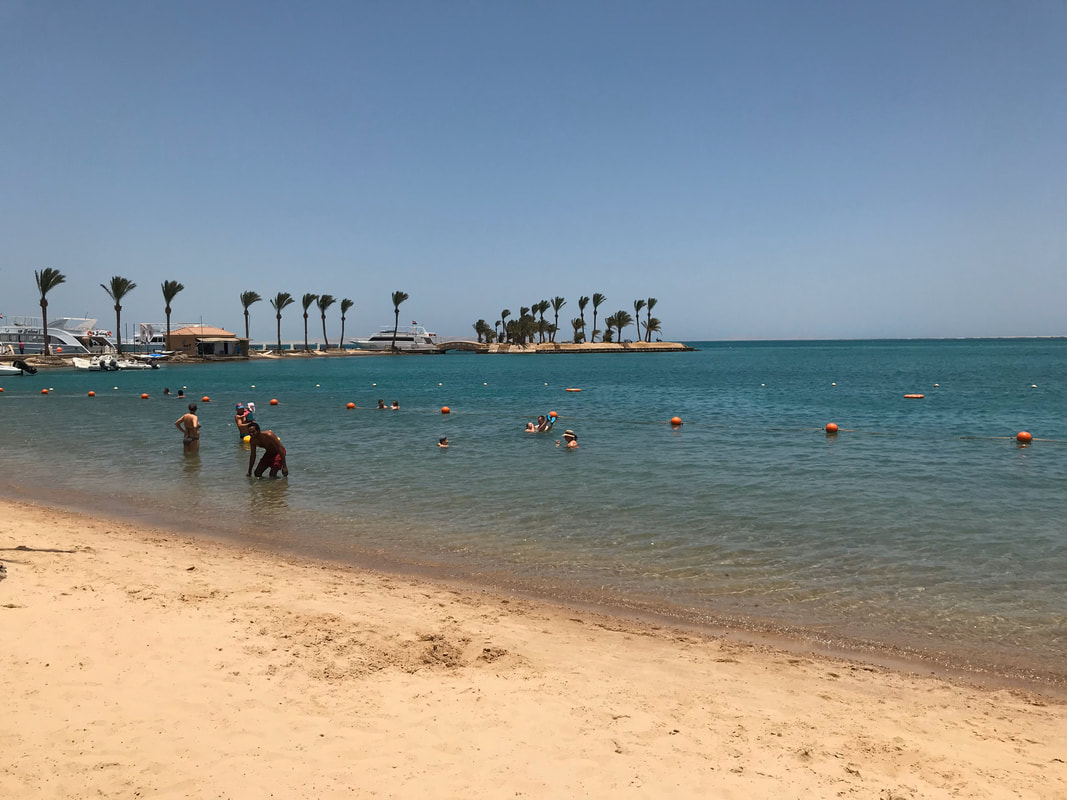











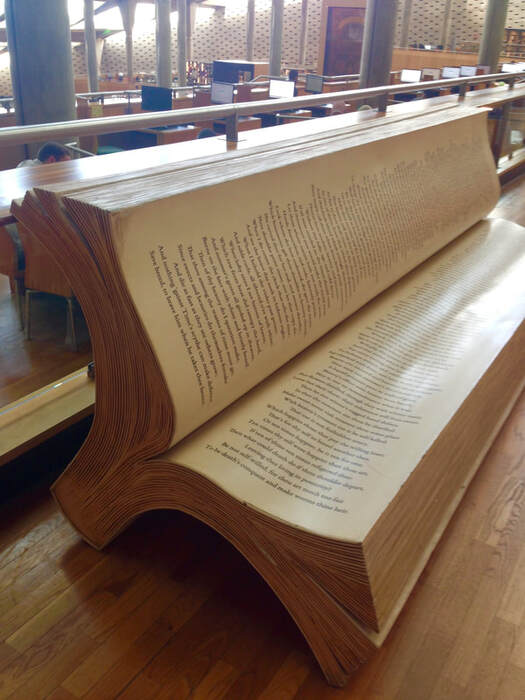

















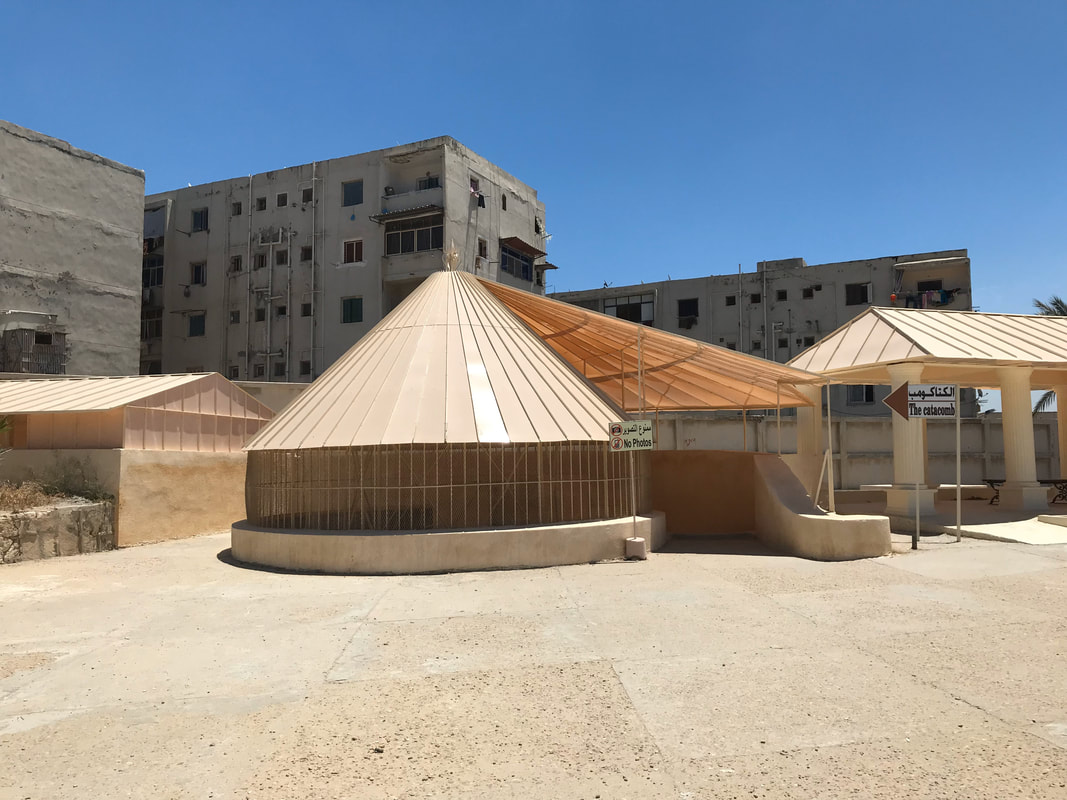

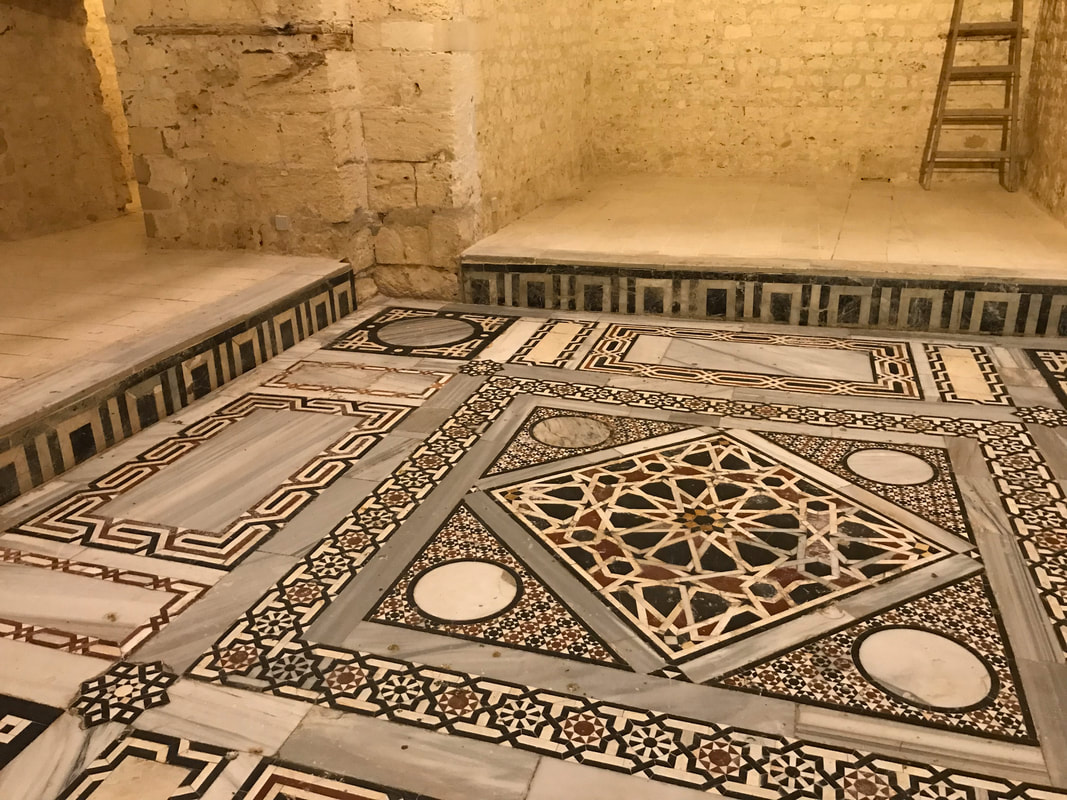


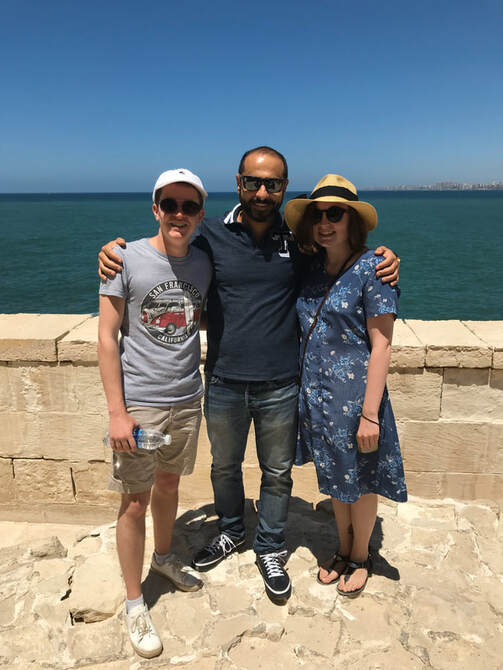


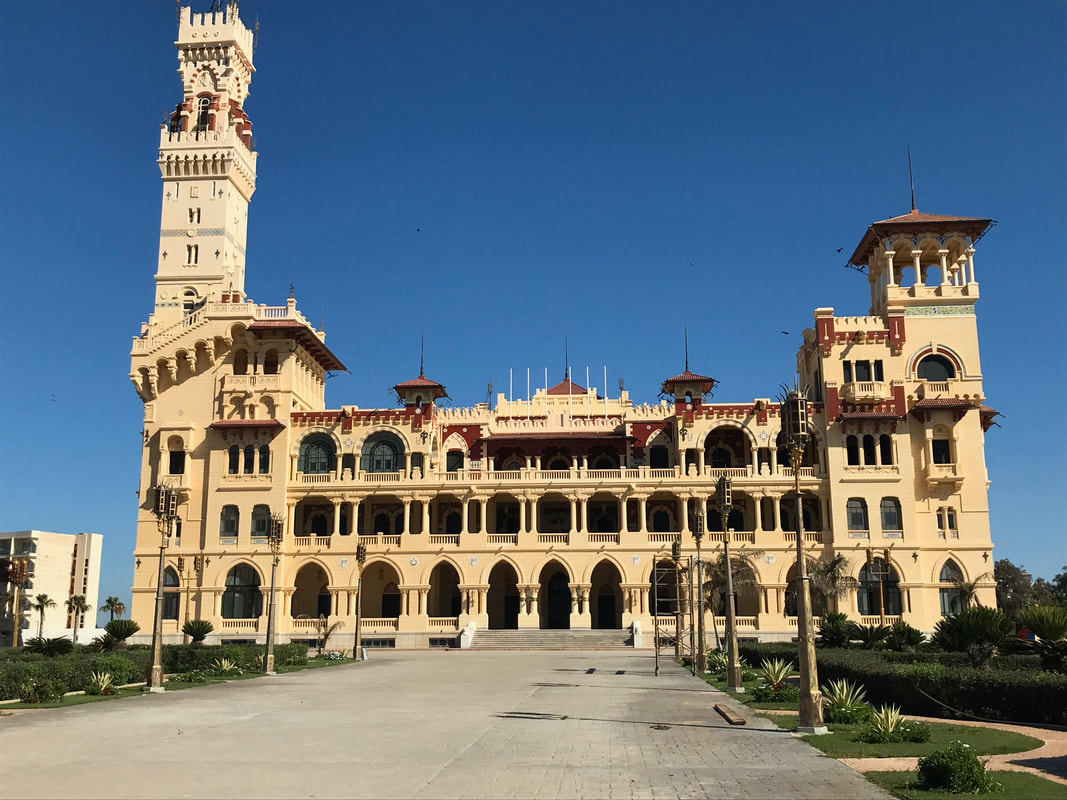





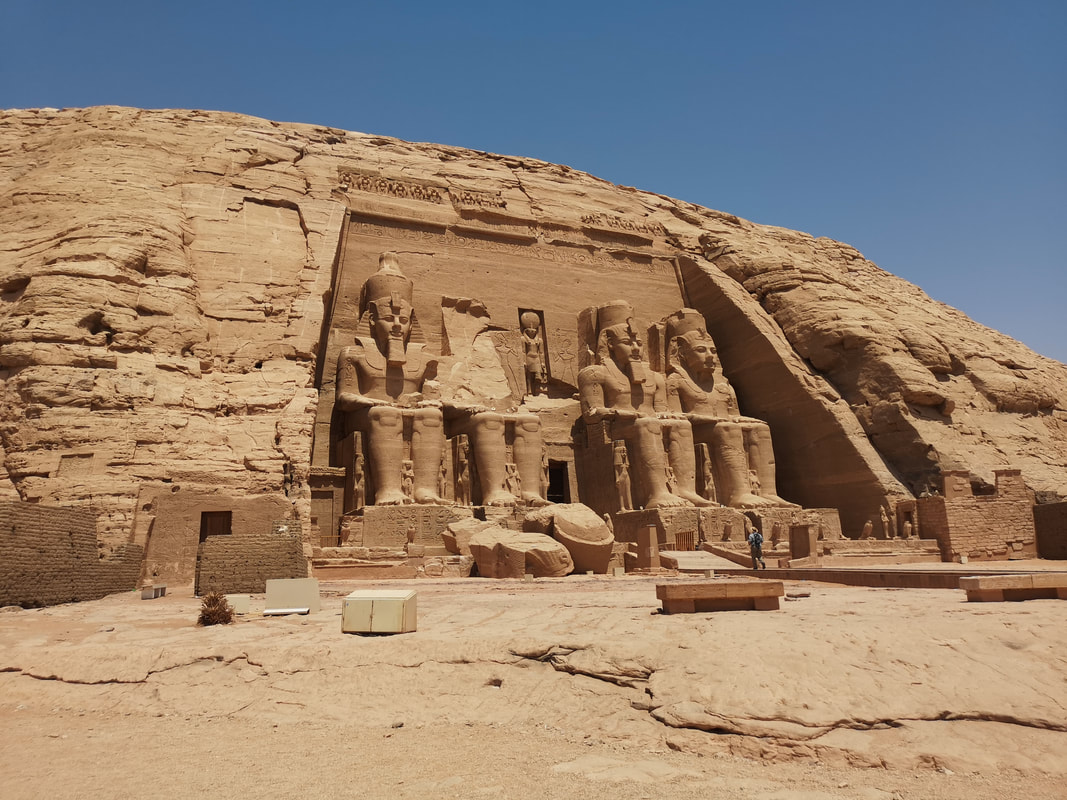


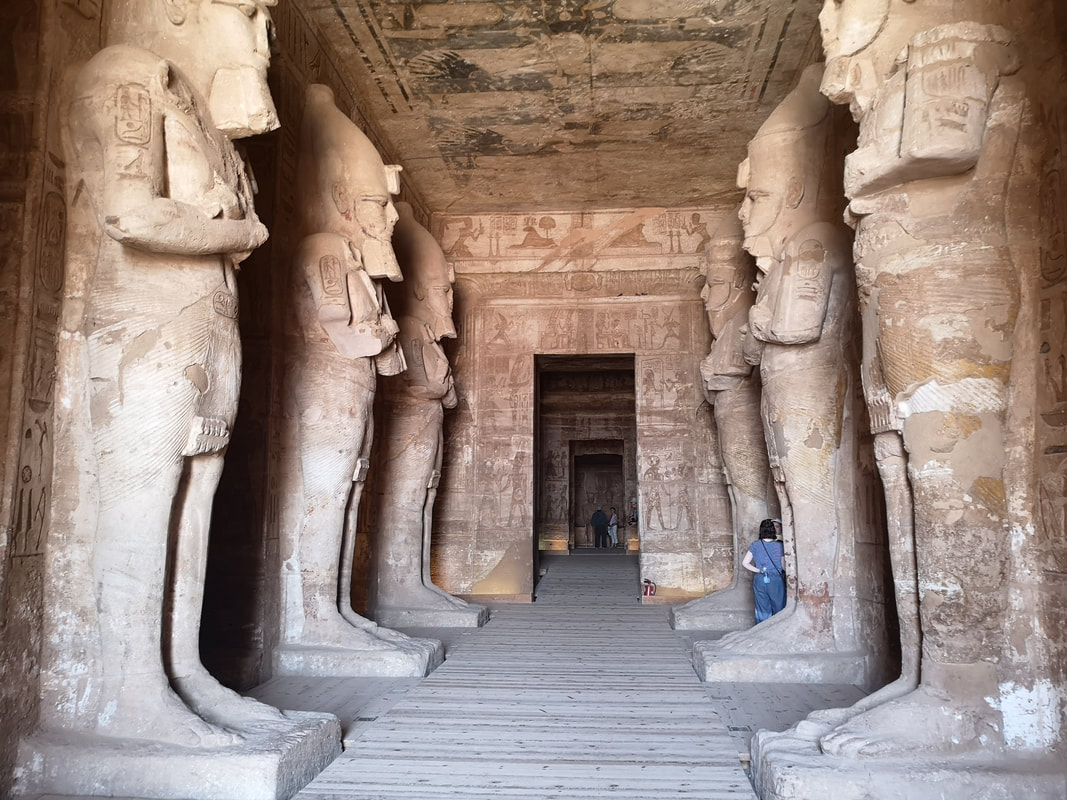

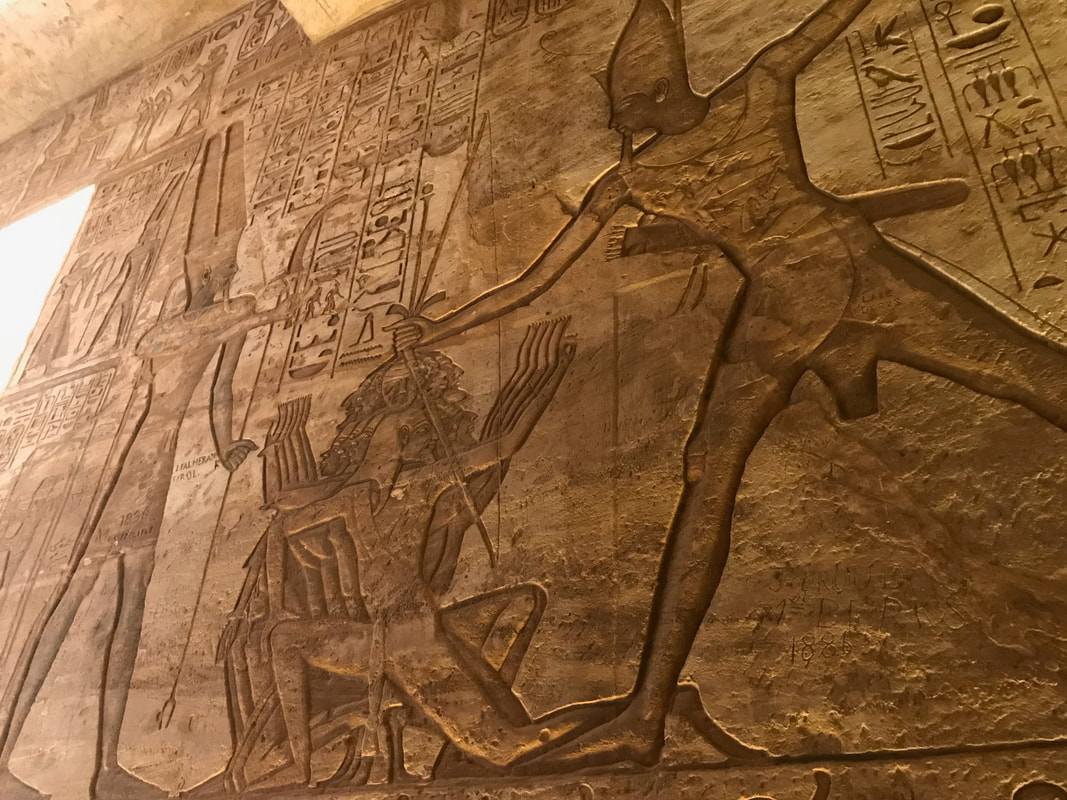


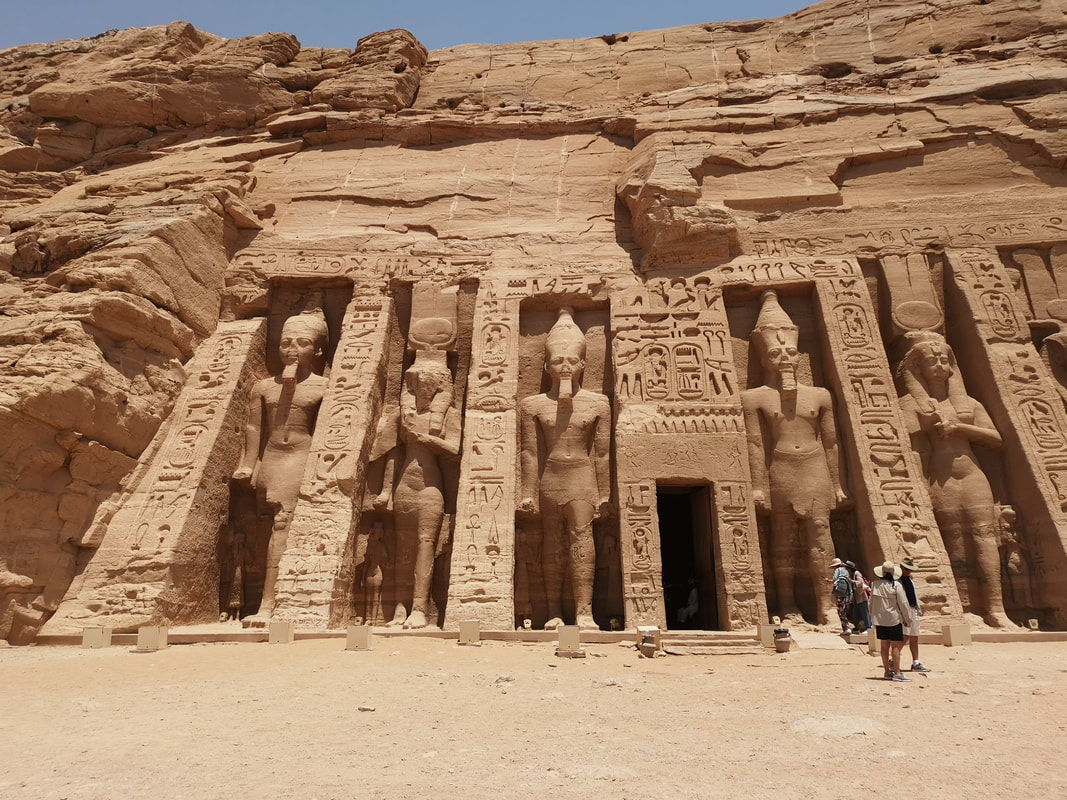
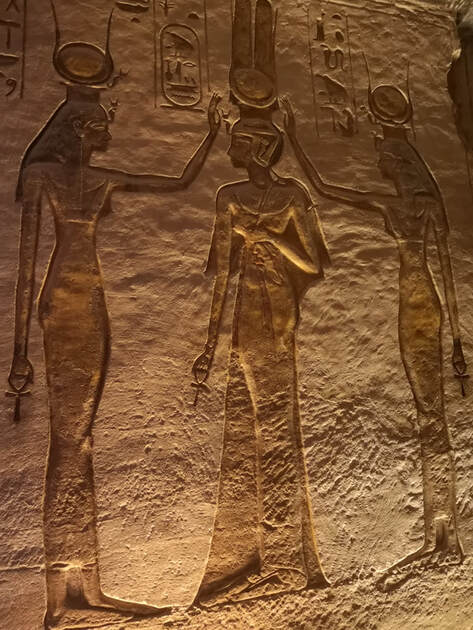







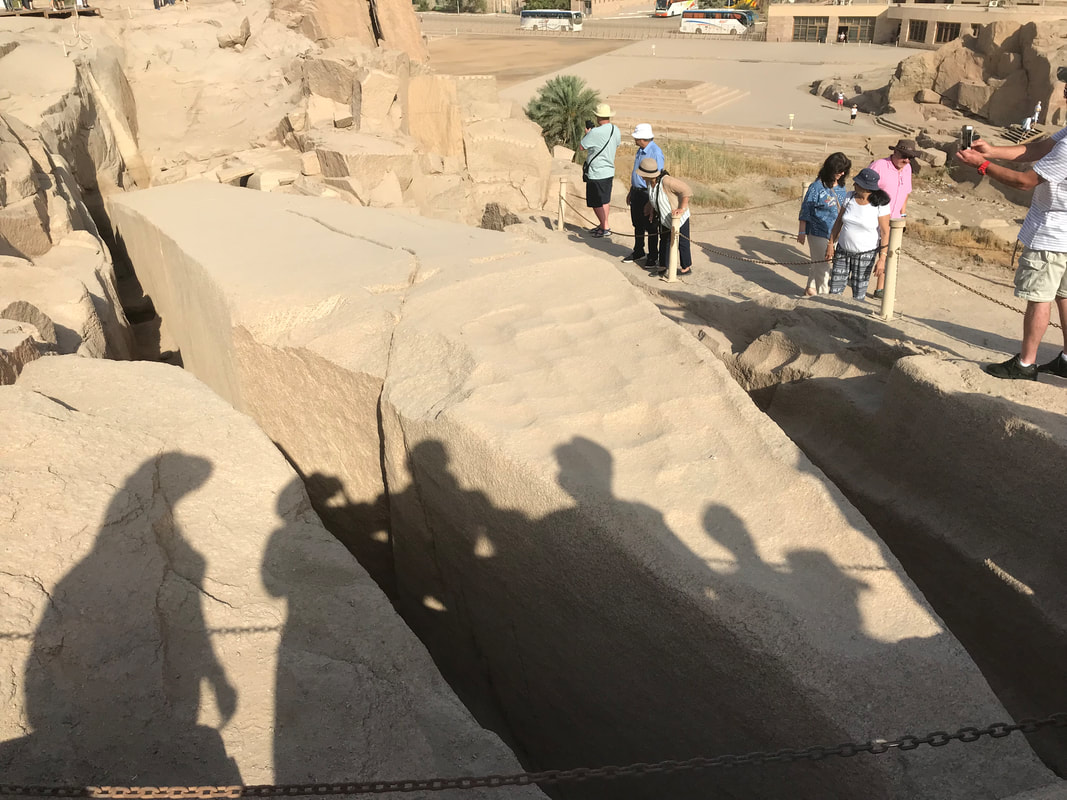






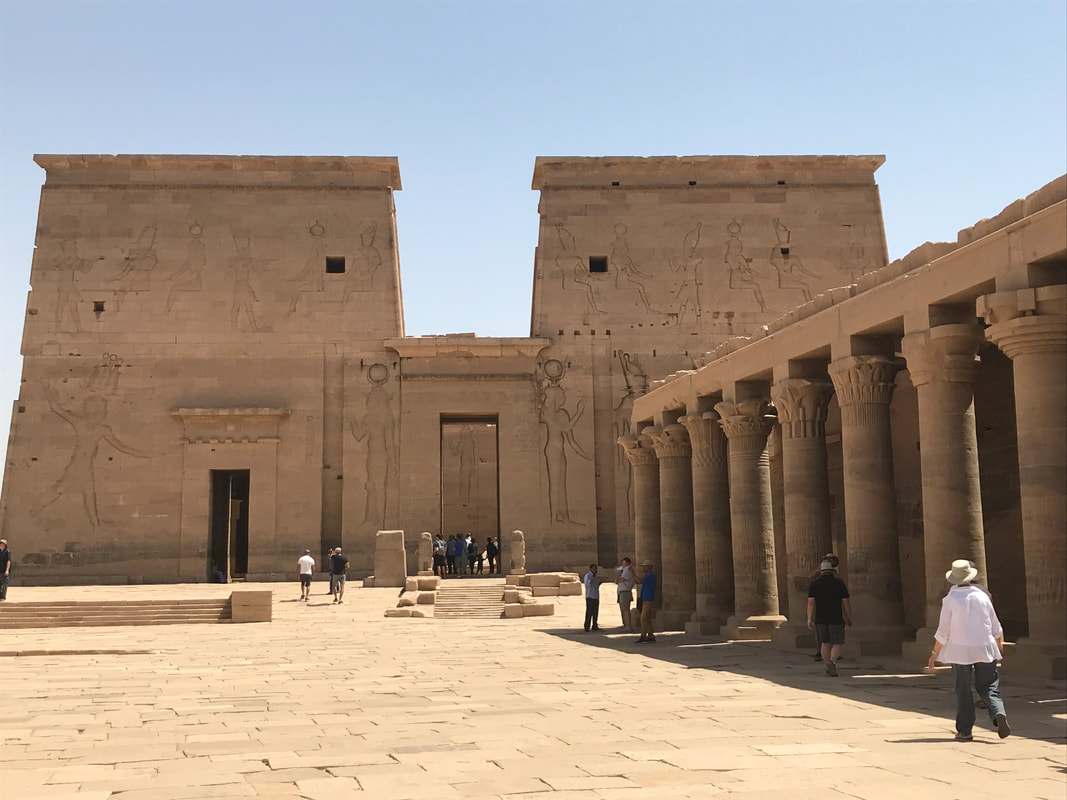
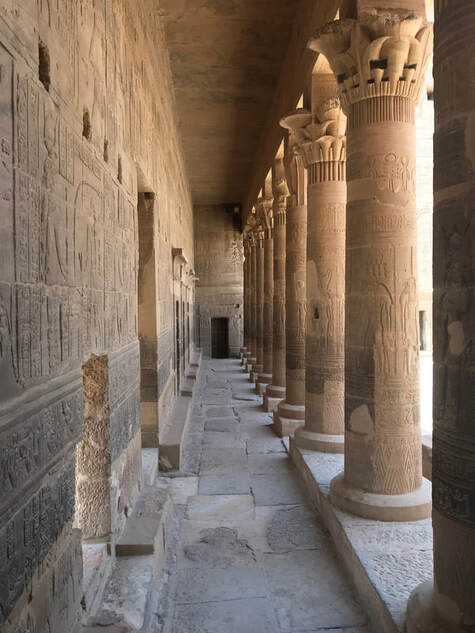





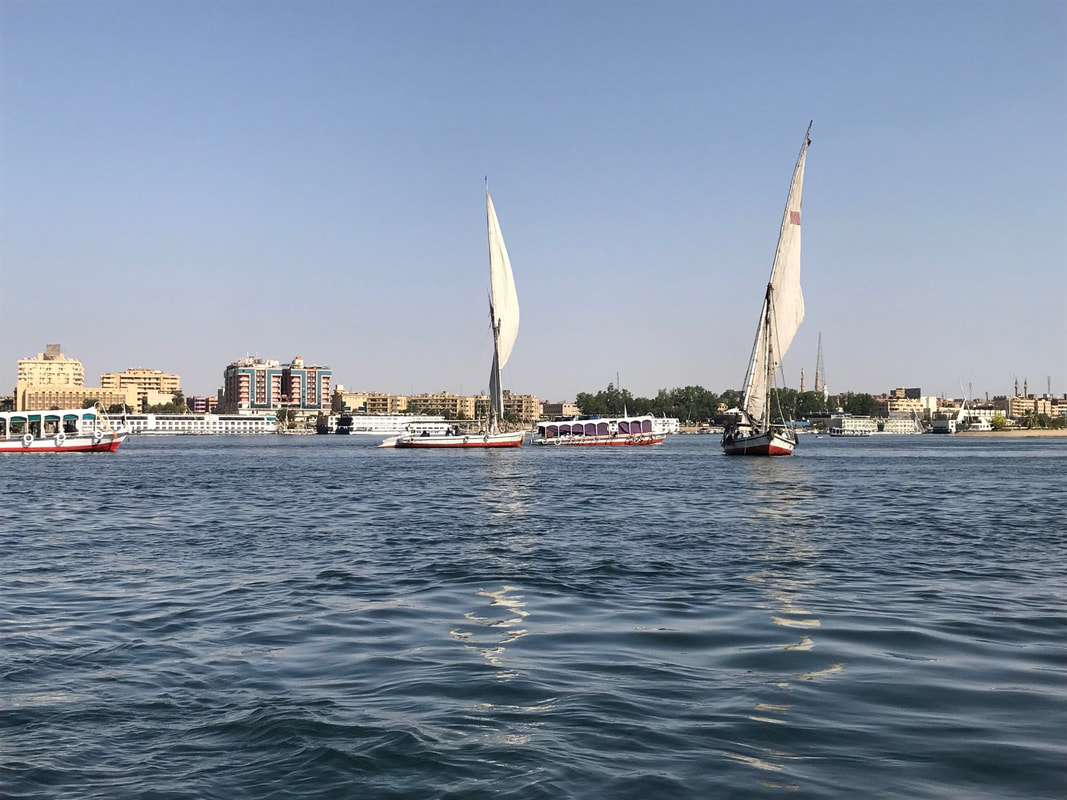








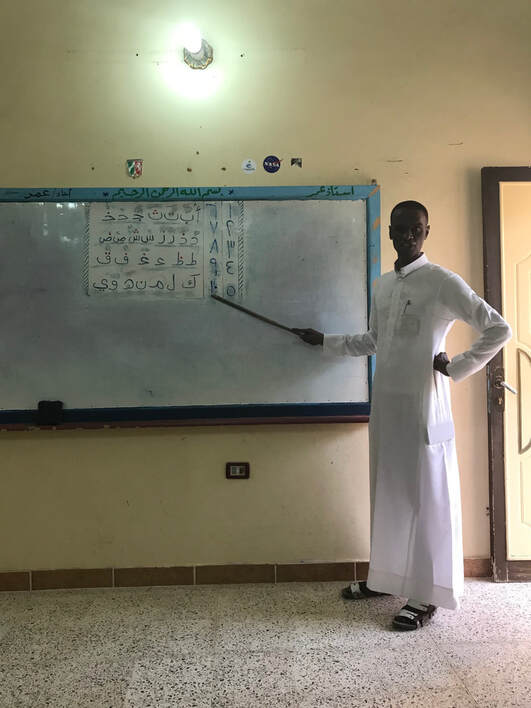
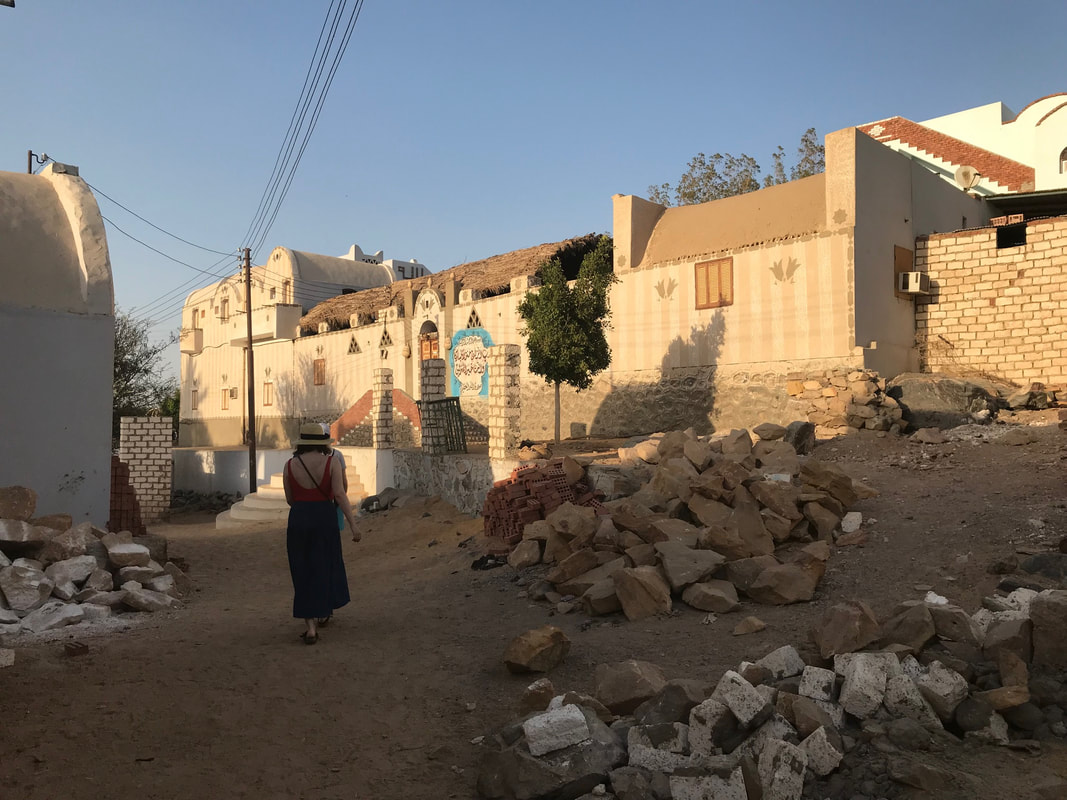





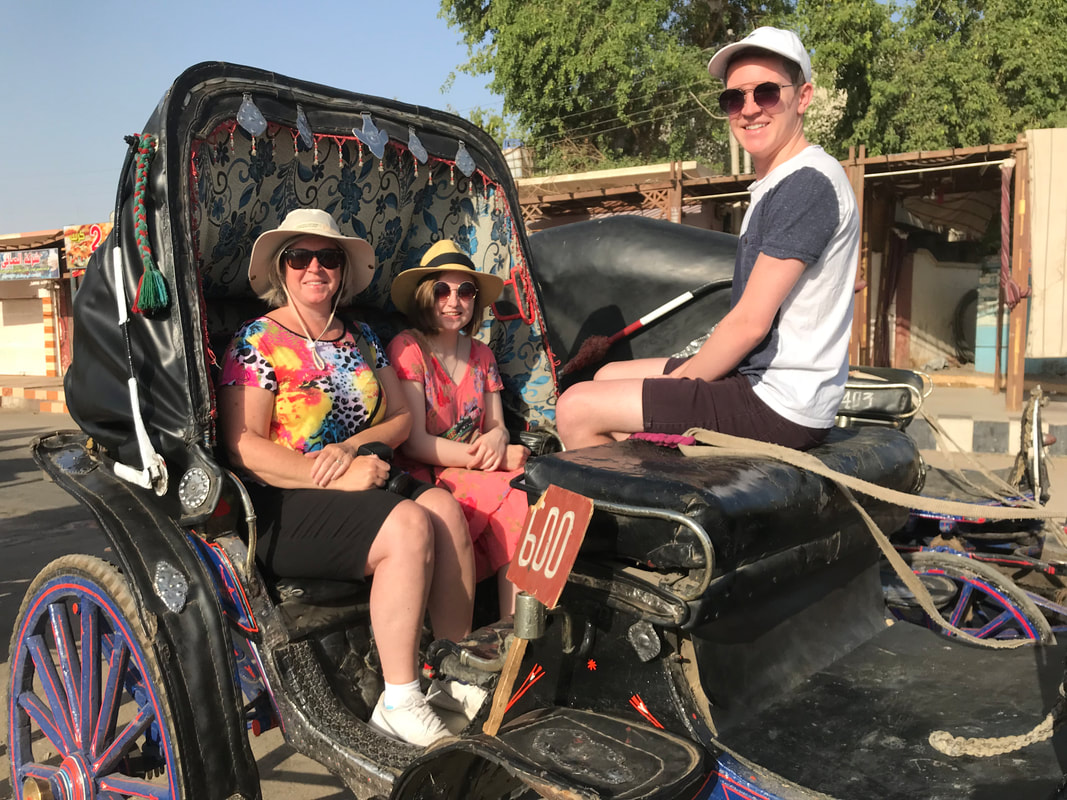


























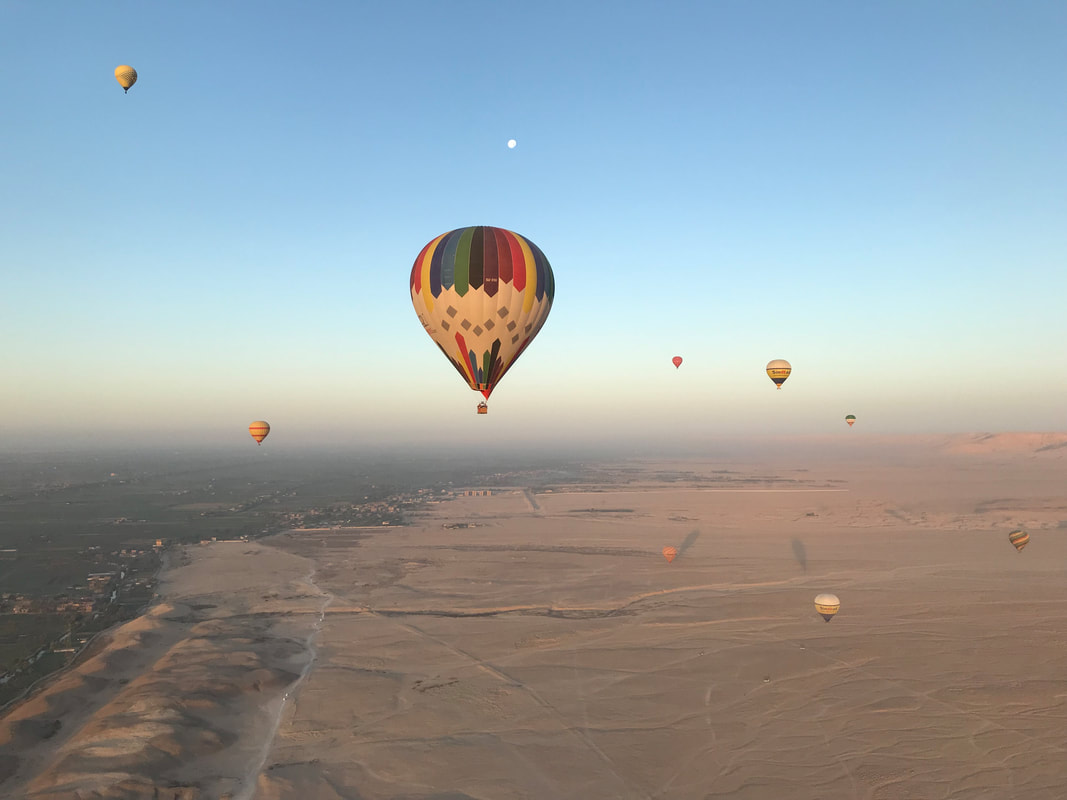









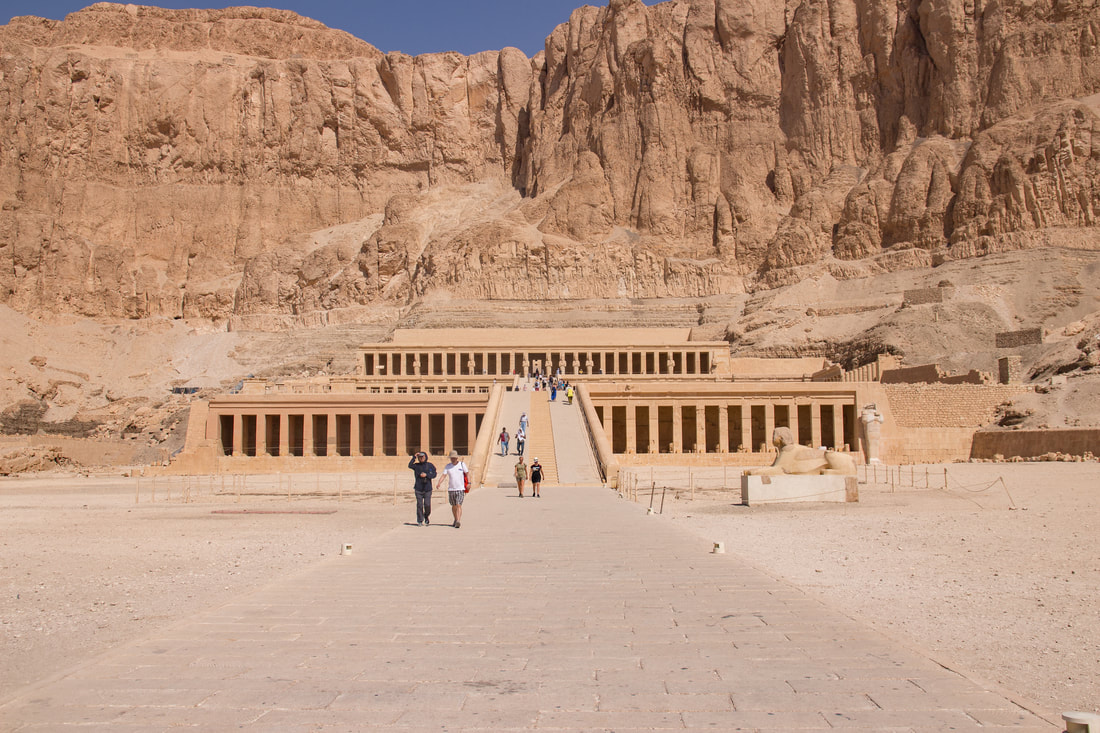
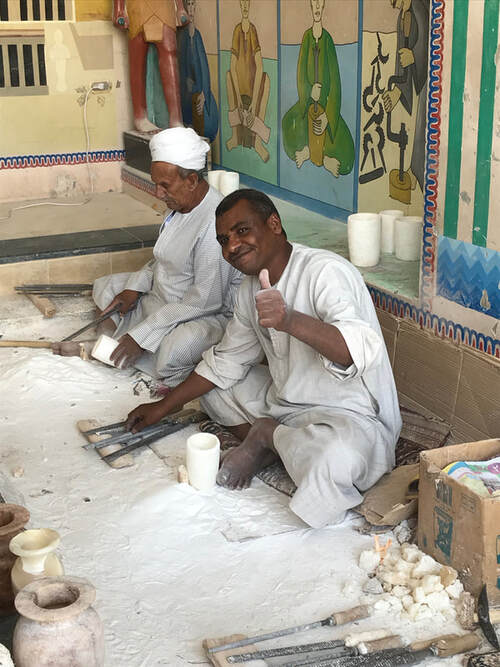
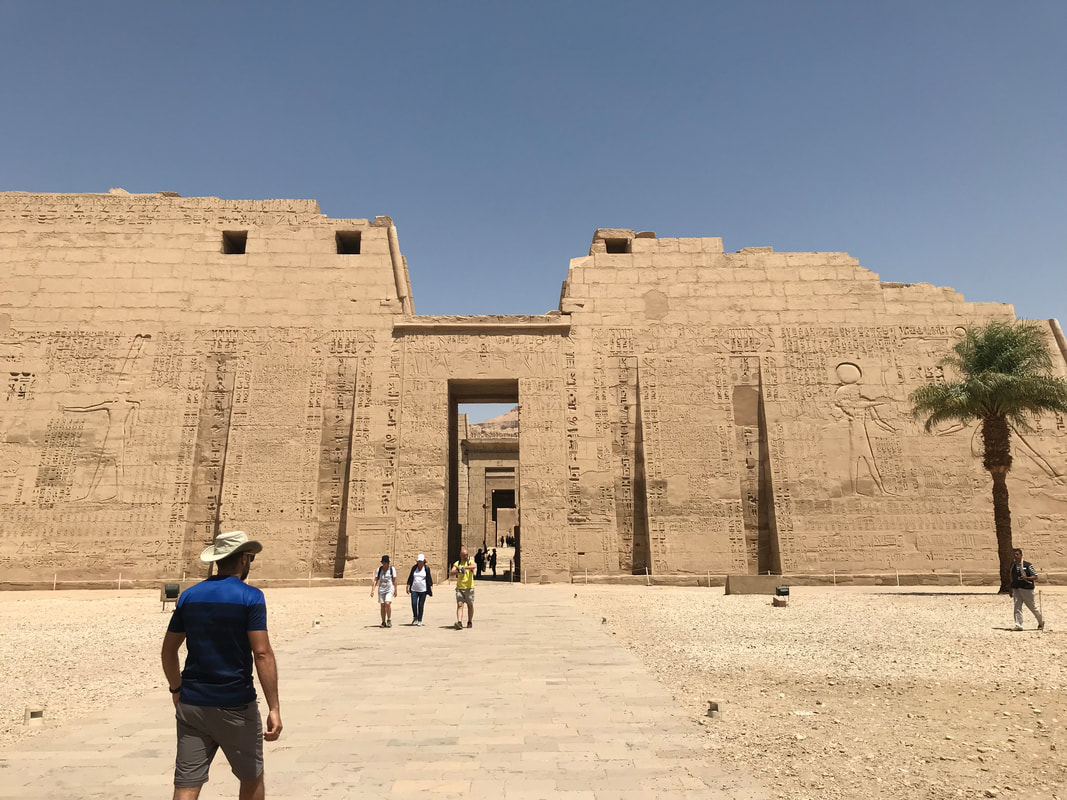
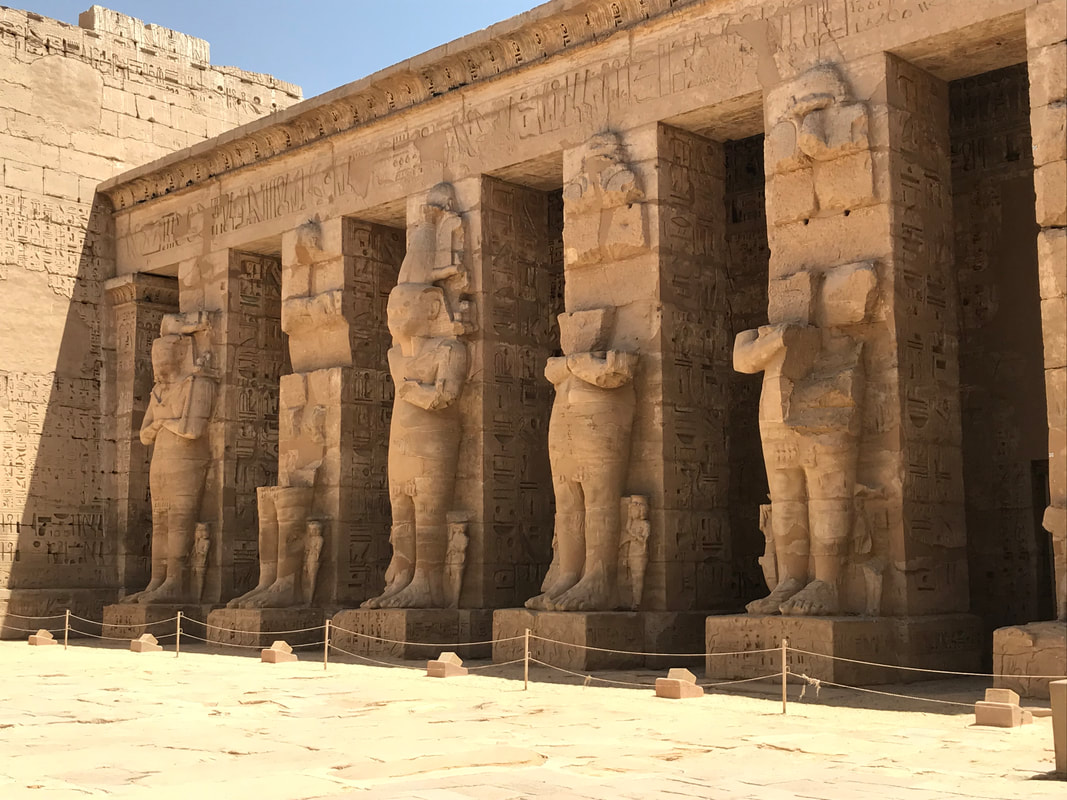










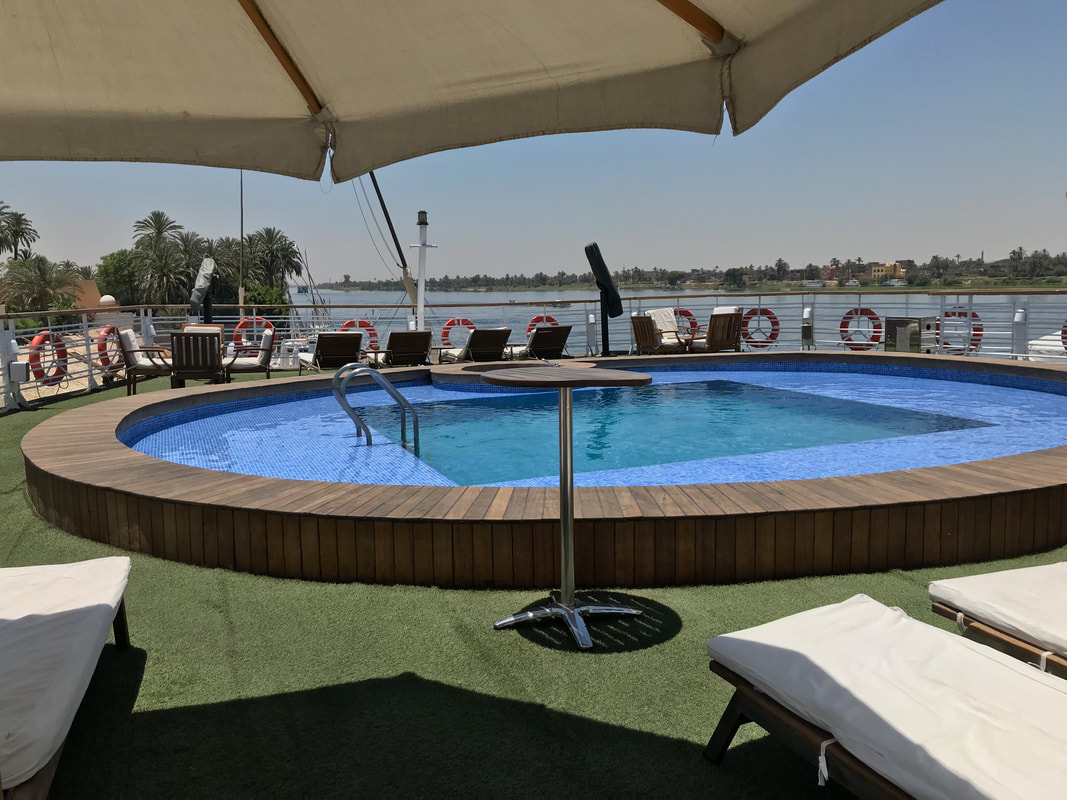


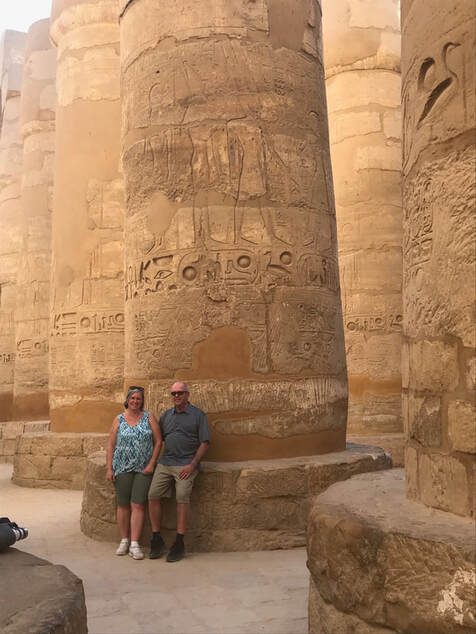





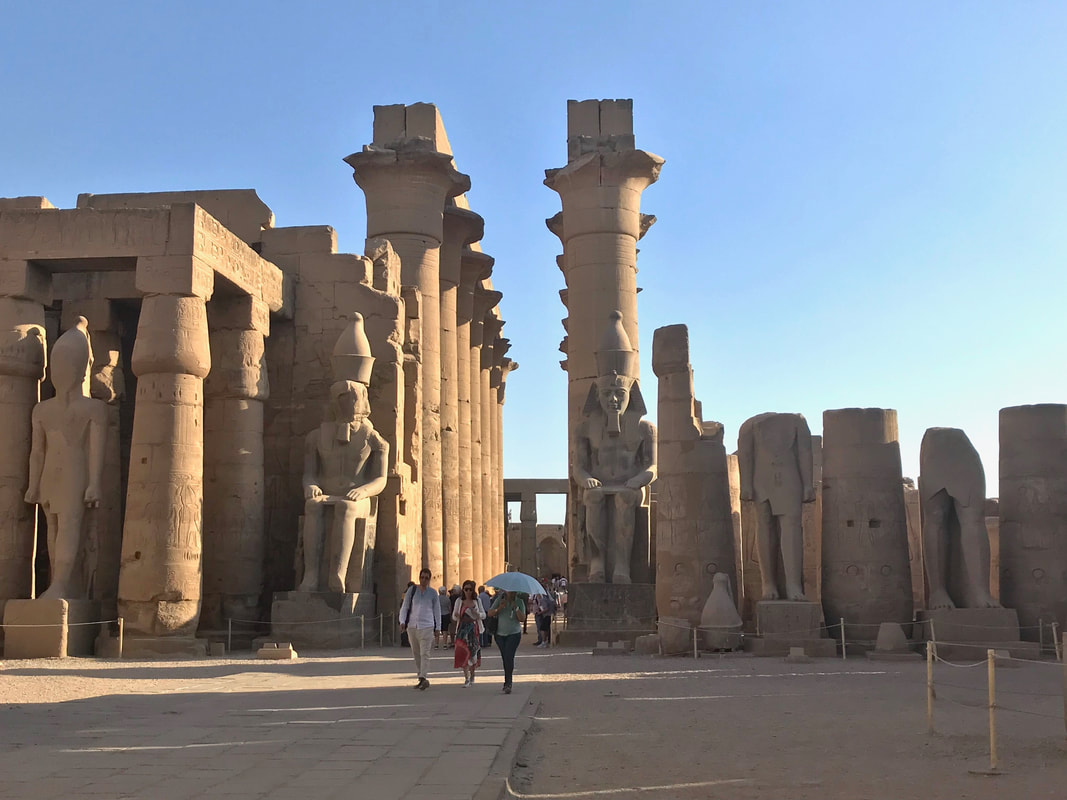






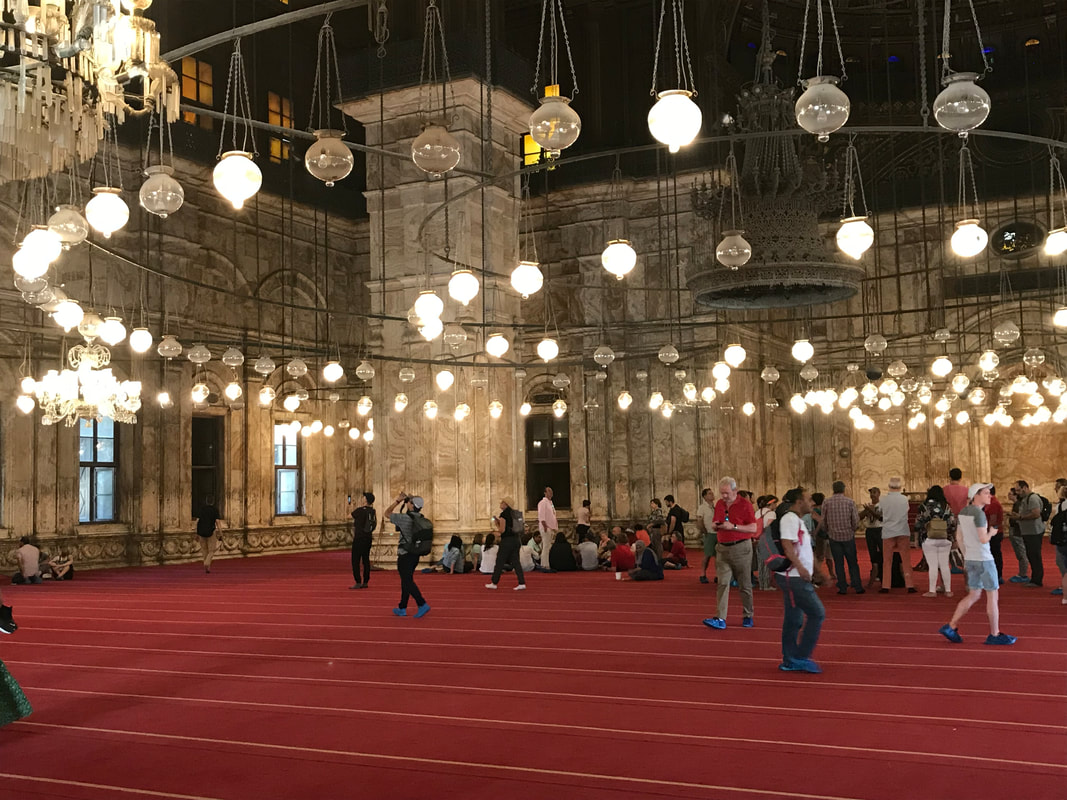














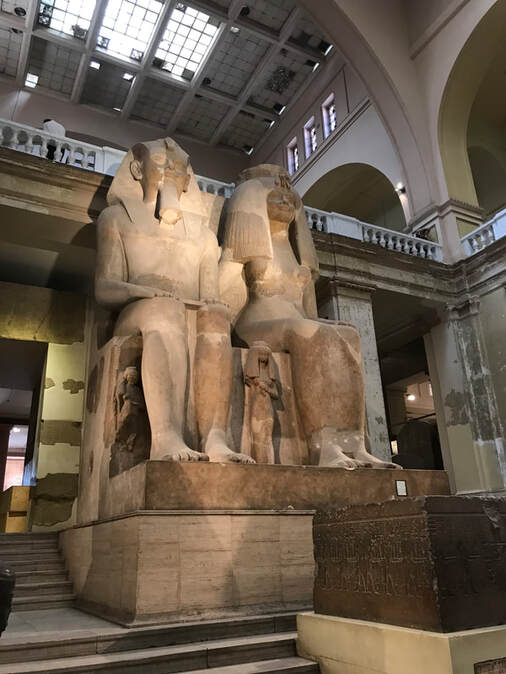









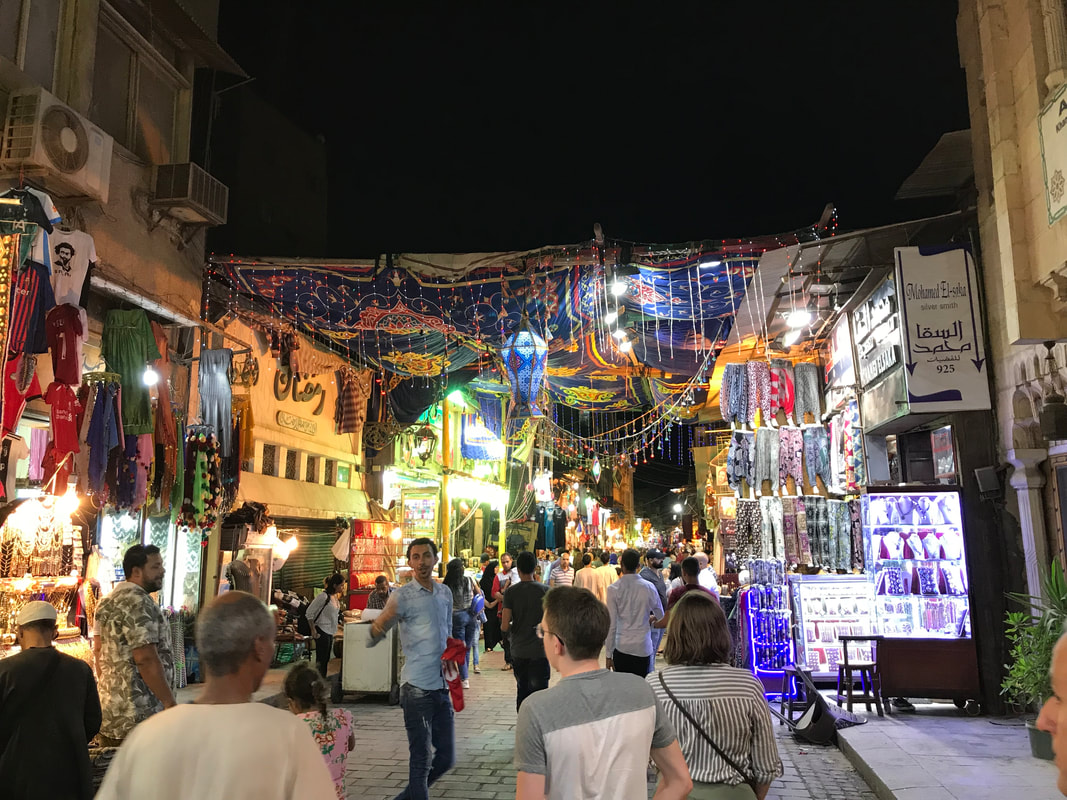




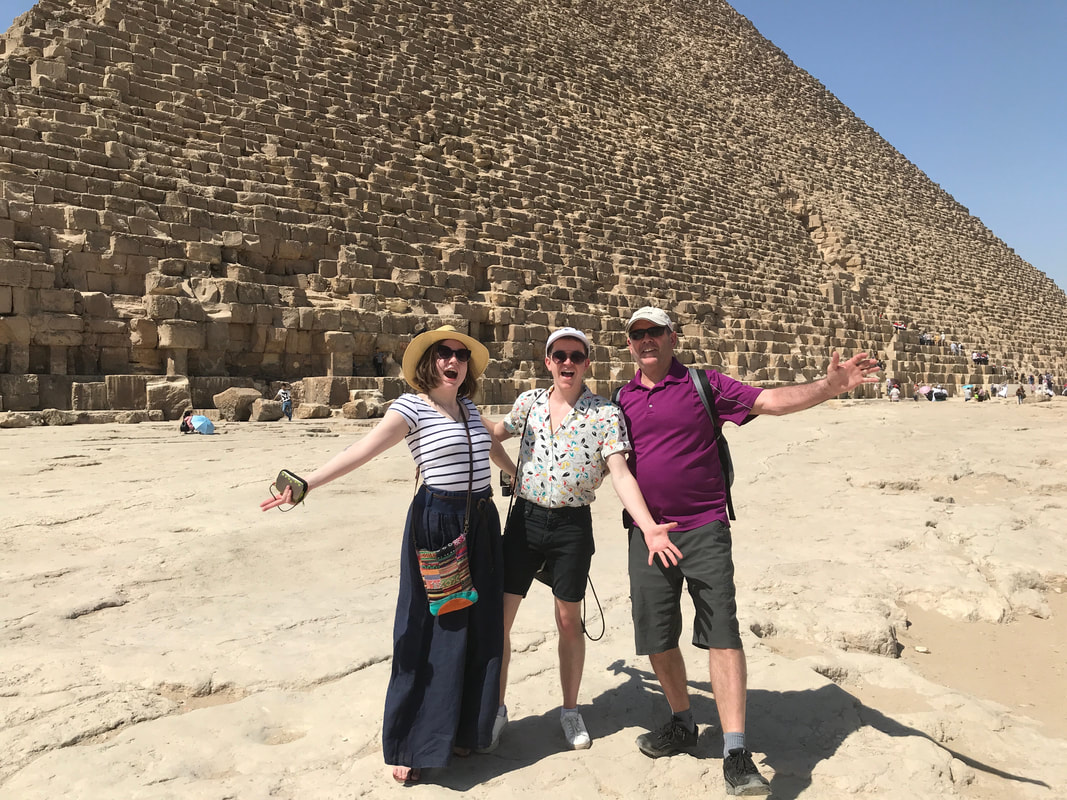























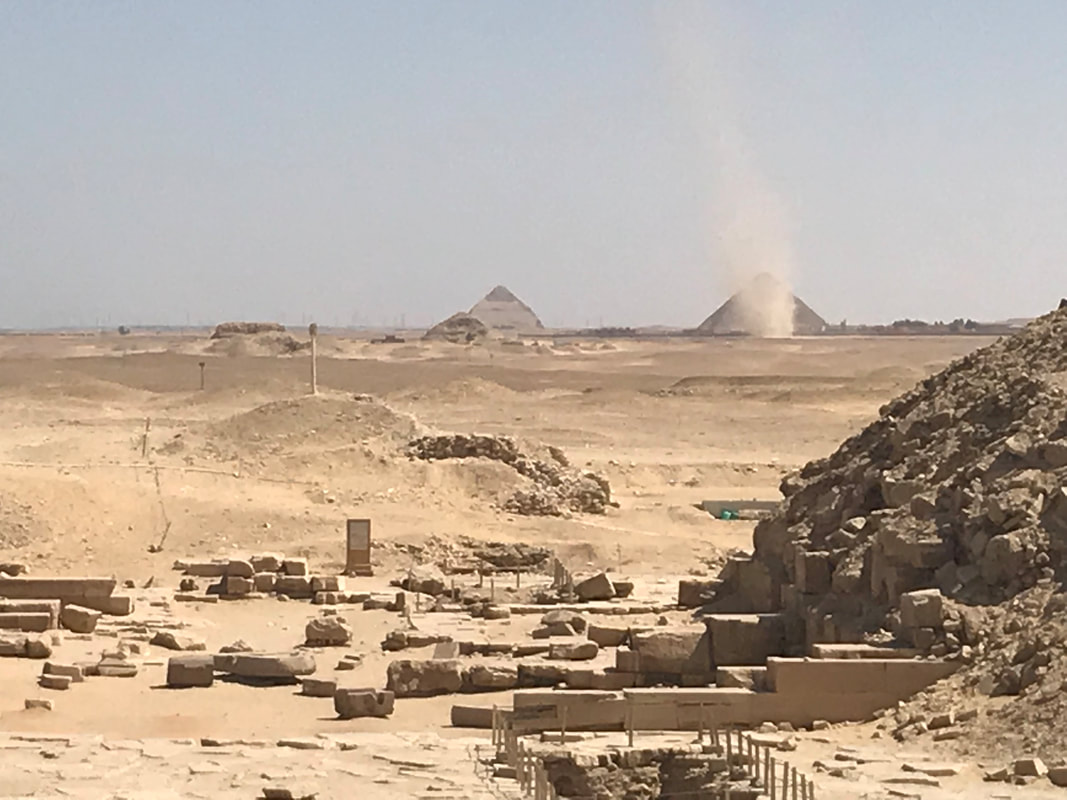
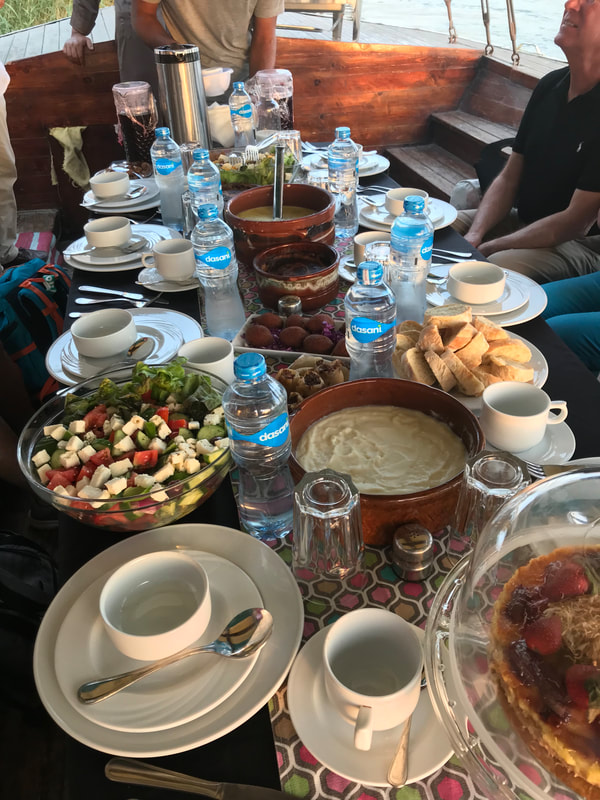









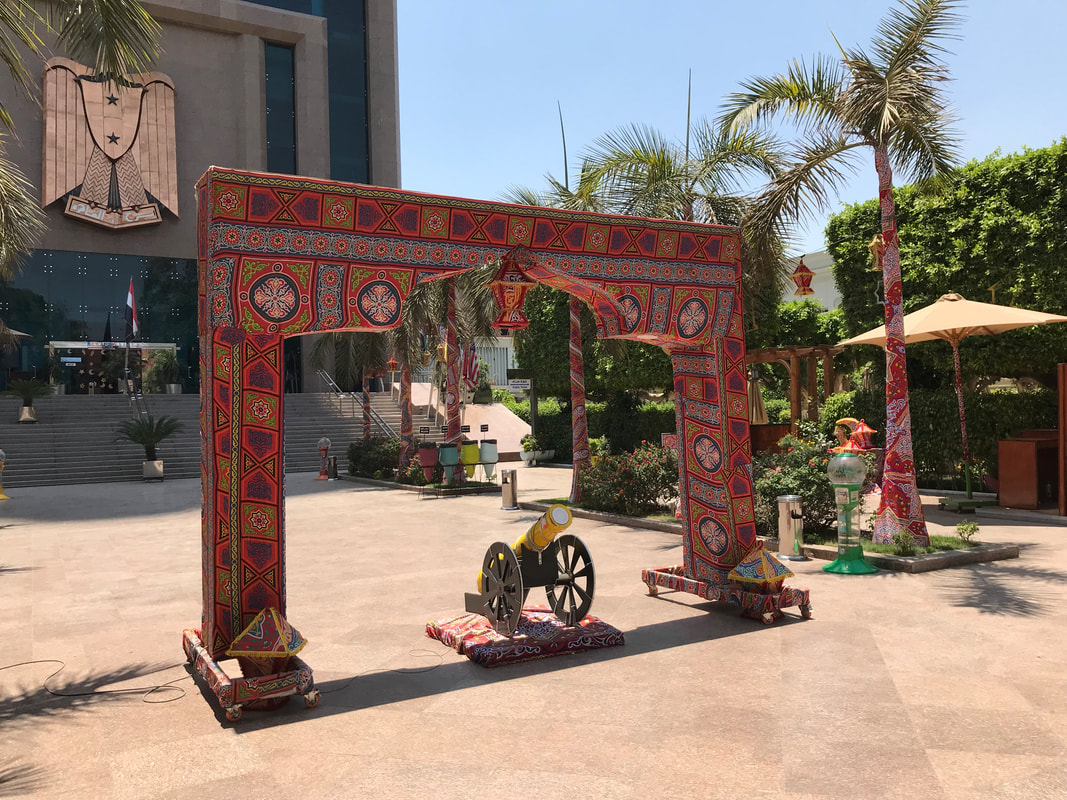
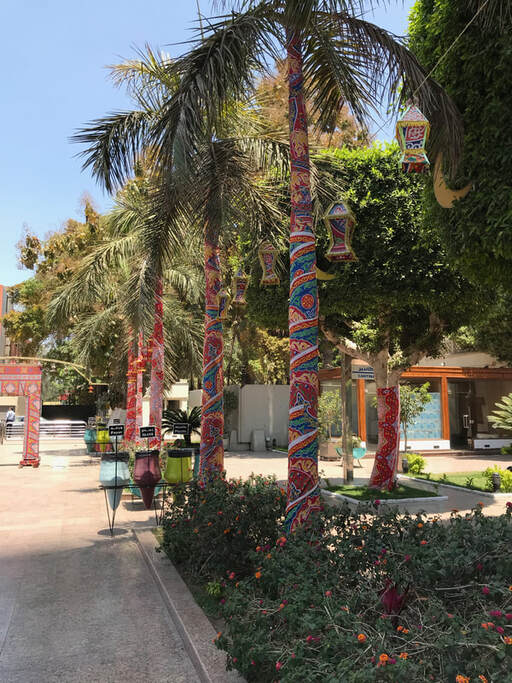

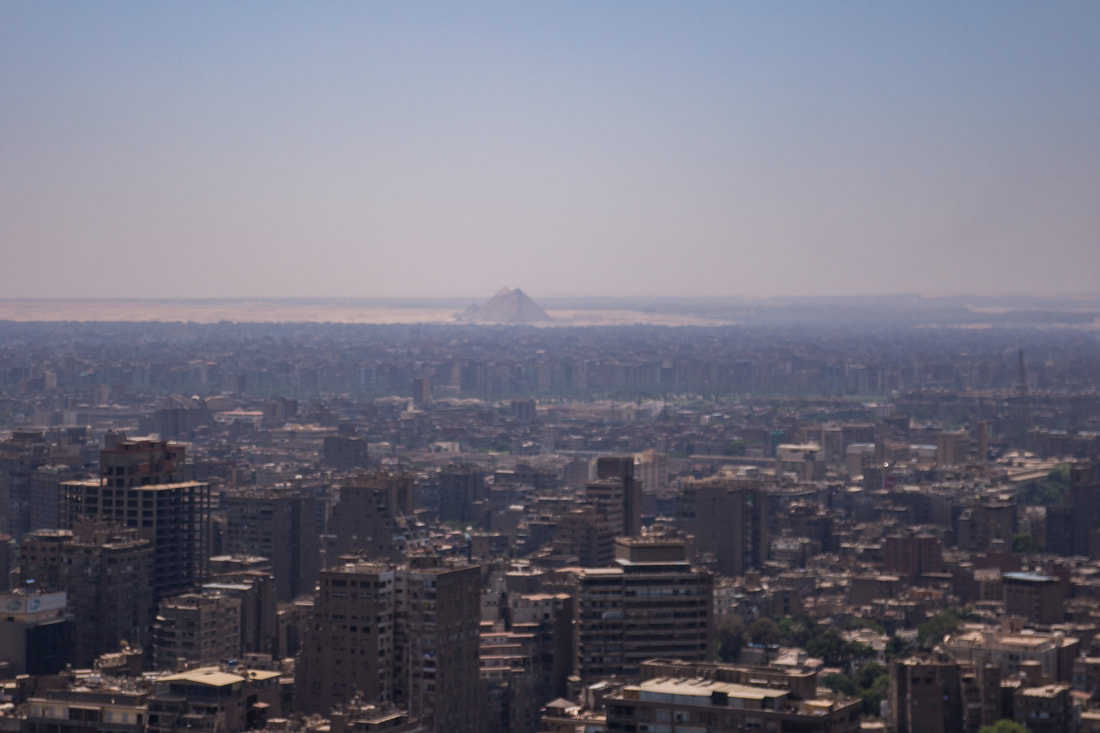




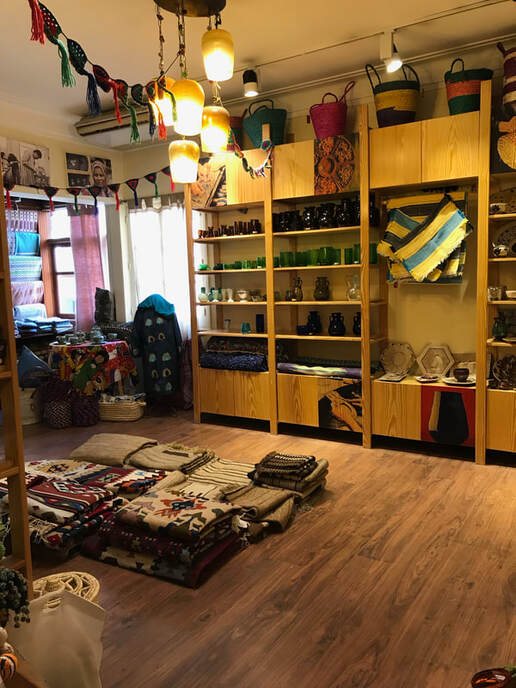
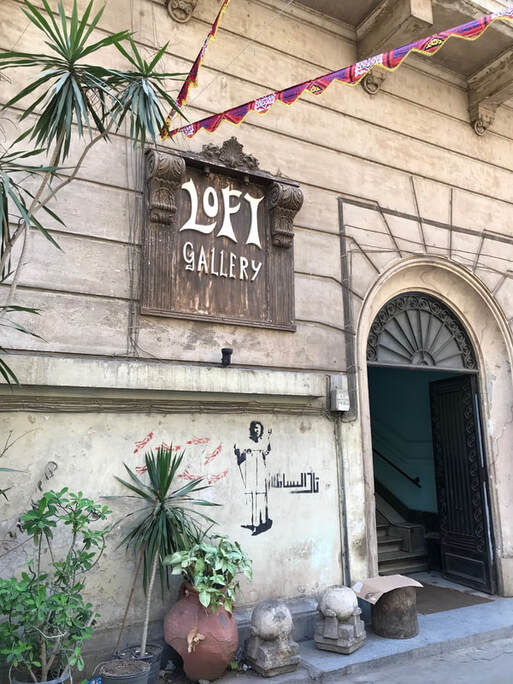

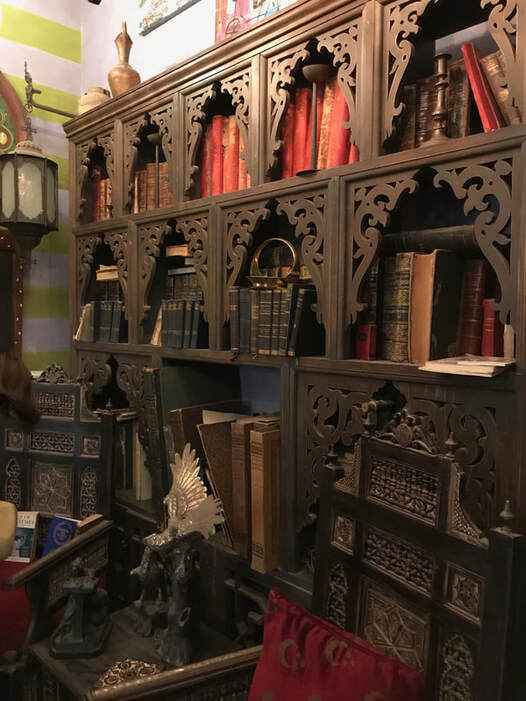

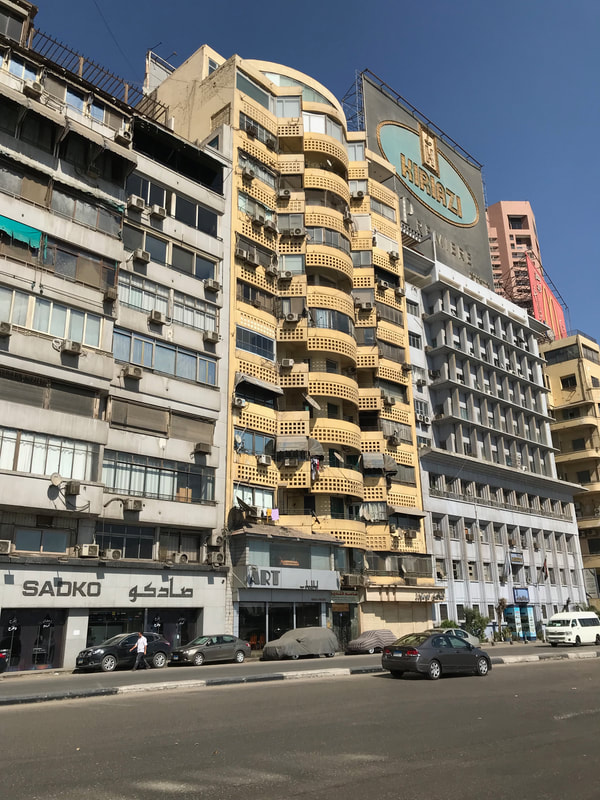




 RSS Feed
RSS Feed